|
|
Wildlife Removal Blog - A Trapper's Journal
This weblog chronicles some of the adventures I have had while operating my wildlife removal company in Orlando, FL - Click any of the photos for a larger image and more information.
Sorted Blogs:
Armadillo •
Bat •
Bird •
Dead •
Opossum •
Rat •
Snake •
Squirrel •
Other Critters •
Repairs •
11.09.2008 - How to Tell if Snake is Venomous / Poisonous
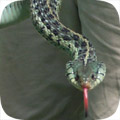 |
|
| The above photo is of a harmless garter snake - yet many people see this snake and assume that it's dangerous. Very few people seem to be able to properly distinguish a venomous snake from a harmless one. As a wildlife removal specialist, I'm
privy to the wildlife opinions of many people. I hear, on a daily basis, just what people think of the wild creatures all around us. It seems that no single type of animal is more misunderstood than snakes. The primary misconception is that snakes are dangerous and must be feared.
In addition, snakes are constantly ...click for more |
10.03.2008 - Mother Raccoon with Babies
 |
|
| Raccoons are excellent mothers. They take great care of their babies. When the babies are young, they stay in a nest while the mother raccoon goes
and forages for extra food to make enough milk to feed them. After about twelve weeks, the young have grown large enough that they start to follow the mother outside of
the nest area (the nest is usually in a tree hollow or an attic) and outside, where they learn from her how to forage for food, and where are the best places to go. They
are weaned by 16 weeks. The young stay with her for some time, up to nine months, and ...click for more |
09.18.2008 - Red Touch Yellow, Kills a Fellow. Red Touch Black, Friend of Jack
 |
|
| Many people have heard this rhyme for snake identification, even though very few people will ever encounter any of the snake species involved. For some reason, it's simply a popular rhyme, and people
seem to remember the idea that there's some rhymey phrase out there to help distinguish between venomous snakes and safe ones. The snakes in question are the venomous Coral Snake,
and a number of copycats, such as the Scarlet King Snake and the Florida Scarlet Snake. Oftentimes in nature, a species will mimic the appearance of a dangerous spe
...click for more |
09.09.2008 - Big Brown Bat Photograph
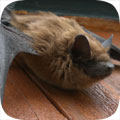 |
|
| This is a detail photograph of a Big Brown Bat (Eptesicus fuscus). The Big Brown is a common bat involved in nuisance wildlife removal, because like
the Little Brown Bat, it's a colonizing mammal that likes to live in buildings. It looks fairly similar to the Little Brown Bat, except it's ...bigger. It has a
wingspan of maybe 10 inches and it weighs 5/8 oz, which while small, is quite a bit larger than your average colonizing bat. I don't deal with Big Brown Bats here in
Florida. I deal with the Freetails and the Evening Bats. The Big Brown is more common up north. This photo ...click for more |
08.14.2008 - Mole Extermination
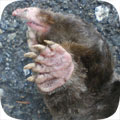 |
|
| This is a nice photo of a Townsend's Mole, taken in the Seattle area by my friend Sean. He traps and removes moles. I don't really do any mole
extermination here in Florida. It's not worth my time, and frankly, I just never got good at it. Mole control is difficult. Even for me, who did it for a
while in Pennsylvania and experimented in Florida. Unfortunately, there is no quick and easy way to exterminate moles. Many people want to buy poison to kill
moles. The problem is that moles eat only live food - almost entirely earthworms, and they won't eat anything inanimate, ...click for more |
07.27.2007 - Raccoon Hunting
 |
|
| Ha ha HAA!!! I've got the little sucker now! I'm going to blast it with my .22 rifle, let the dogs get at it, skin it, tan the hide, make raccoon stew, and pick my teeth with the bones! Rar! That raccoon doesn't stand a chance against my superior
manly intellect and my super manly weapon that I carry with me. I can't wait to take my rambo knife to this sucker's throat! No way you could outrun my trusty pack of hound dogs, you sneaky little raccoon. You thought you could get away from me, but now it's lights out!
The final curtain for you! I see you trying to hide up in that tree, you ...click for more |
07.15.2008 - Male Bat Roosting in Tree
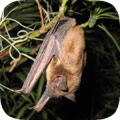 |
|
| Whenever I remove bats from a home or building, I inform the person with the problem that their bats are all female bats, known as a maternity colony. When bats gather in a large group, it's for the purpose
of forming a safe haven to give birth to and raise young bats. The exact time of birth and weaning depends on species and latitude, but in North America, it's always in the summer. Female bats only give birth once per
year, and again depending on species, often to only one pup. After I tell the person this, I hear the inevitable follow-up, "where do the males go?"...click for more |
07.14.2008 - Eastern Diamondback Rattlesnake
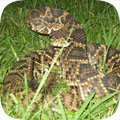 |
|
| This is an Eastern Diamondback Rattlesnake that I caught. It's a good sized specimen. This snake lives throughout most of the
state of Florida, but it's pretty rare in the Orlando area. It's rare in most developed areas, because it's a slow snake and it stands its ground, and people have a habit of
killing them off. It's true that the bite of this snake is very dangerous - many herpetologists think it's one of the 10 deadliest snakes in the world - but it won't strike
unless provoked. Nevertheless, most people don't like to have them around, so where there's people, there's ...click for more |
07.02.2008 - Cute Baby Wildlife
 |
|
| Although I specialize in wildlife removal, I also like to take photographs of the critters from time to time. I really enjoy the baby wildlife. Kind of like how most people enjoy puppies and kittens. It's hard not to like these cute little guys.
Many people think that the adult opossum is an ugly animal. However, the baby is downright adorable. Just look at those little hands, that pink nose, those little
ears and those big brown eyes! I could just eat this little fellow right up! I also like the blue patches in the ears. It's generally accepted that all
animals have a paternal response to juven ...click for more |
06.19.2008 - Raccoons In Garbage Can
 |
|
| Raccoons are very urbanized animals. Studies reveal that raccoon population densities are about ten times as high in urban areas than in wild areas.
Cities and suburbs simply have more of the resources needed for raccoons to survive - shelter in our attics and under our buildings, and food from pet dishes, handouts, and of
course dumpsters and trash cans. I frequently get calls about raccoons that are causing problems around dumpsters and garbage cans. Raccoons are very strong and
crafty, and they make a big mess. They love to tip over garbage ...click for more |
06.03.2008 - Raccoon Holes Leading Into Attic
 |
|
| Here are a couple of classic raccoon entry points. This house has wooden soffits. Oftentimes, homes such as these have vent holes in the soffits.
These vent holes are a standard size and shape, about a food long by four inches wide, with round ends. This hole may not look very large, but animals can squeeze through
very small areas. While it's easy to imagine a rat or squirrel running through these types of holes - and they do - a full sized raccoon can also easily slide through
these openings. Yes, a big fat raccoon. In the above photos you can see a lot of muddy foot ...click for more |
05.15.2008 - How to Prevent Rodent Damage in an Attic
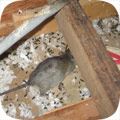 |
|
| Rodents that live in attics cause more problems than just annoying noise. They also cause a number of different types of damage inside an attic, some of
which are serious. Look at the above photo, and you will see several types of rodent damage in this customer's attic. Rat Droppings - Rats have high
metabolisms, and they leave many droppings, often thousands, in an attic where they live. These droppings may or may not smell bad, but they are unsightly and they do
carry disease that people can contract if they come into contact with the droppings. Rat Urine ...click for more |
04.20.2008 - Pigeons in the Attic - Get Them Out
 |
|
| Pigeons thrive in urban areas. They are one of the few animals that thrives with people in general.
They like to live on buildings, and they like to live in buildings, and this means that they like to live in the attics of homes when they can get access.
I deal with many cases of pigeons in attics each year. The first step is to remove all of the pigeons. I accomplish this via a number of tactics, from
the use of one-way exclusion devices to physical removal. The second step is to seal off all of the entry points so that no more pigeons can enter the
building again. The third ...click for more |
04.14.2008 - Types of Florida Water Snakes
 |
|
| Several species of water snake slither and swim their way through Florida's lakes and swamps. The most feared is the venomous
Cottonmouth, or Water Moccasin, as some call it. While these snakes are in fact common in some areas, and while you certainly don't want to be bitten by such a snake, most of
the water snakes in Florida are in fact harmless. The above photo is of a Brown Water Snake that I caught. This snake poses no danger. It's not poisonous, and is usually
docile. Any snake can strike if provoked, but most would much rather just swim away in ...click for more |
04.14.2008 - Playing Possum
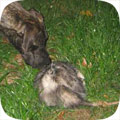 |
|
| Everyone has heard about "playing possum". It's a defense mechanism of the North American Opossum. If it's attacked by a predator, sometimes it completely passes out, and appears dead. It is the instinct of many predatory animals to shake and kill a
critter that is moving or fighting back, but they often leave dead animals alone. Thus, if attacked, by feigning death, the opossum doesn't receive any further attack. With luck, the attacking animal loses interest and leaves. The opossum wakes up after 15 minutes or so, and
walks away. As far as I know, this defensive tac ...click for more |
04.11.2008 - Dead Animal Carcass Removal Under House
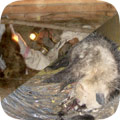 |
|
| I am the best. The best there ever was or ever will be. At removing dead animals from homes. That's it though, I'm not the best at anything else. This here job wurn't too
tough, but it were tough enough that neither the homeowner or the first company they called couldn't git er done. I got her done in one minute, forty two seconds. The house smelled horrible. I stepped inside and I knew it
was a dead opossum. Dead possums smell different from dead rats, cats, bats, or shower mats. My nose led me right to the air vents - a rare source for the odor, but I could tell. I could ...click for more |
04.08.2008 - Raccoons Tearing Up Sod
 |
|
| Here's a common problem that people have with raccoons - the destruction of sod. If you have your yard re-sodded, watch out for raccoon problems!
Raccoons are very clever, and they have nimble hands. When yards are sodded, it's common for tasty earthworms and grubs to live right under the sod, on the surface of the
soil. For some reason, raccoons always have a tendency to know that there's food to be had, and they just peel back the surface of the sod like a rug, and eat the tasty
morsels underneath. I was called out to trap a troublesome raccoon that was ...click for more |
03.29.2008 - Mole Poison
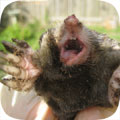 |
|
| "Blargh!", said the above mole as it gasped its last breath before dying. This mole was murdered. But how? BY POISON! Yes, mole poison
killed this mole. I know, because I poisoned it myself. I invited this mole to a fancy dinner, but little did he know that I placed cyanide in his wine. Just
a few sips, and he keeled over as I cackled with laughter. This mole will dig up my yard no more. Of course the above story is fictitious. I actually used
iocane powder. Okay, I didn't use poison at all. There is no such thing as an effective mole poison. I say effective, ...click for more |
03.15.2008 - Mouse in Attic - Trapping & Removal
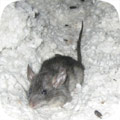 |
|
| Here is a rare photo of a mouse in an attic. If you want to solve a problem with a mouse in the attic, you have to follow the steps I've outlined many times on
this site. Step one, inspect the entire house, top to bottom, identify the areas of mouse use in the attic, and find any possible entry holes that lead into the house.
Step two, seal the entire house shut, with steel repairs. Step three set a dozen or more mouse traps on the prime locations in the attic. Step four, remove trapped
mice and reset traps until no more are caught. Step five, clean and decontaminate the attic. ...click for more |
03.13.2008 - Flying Bat Photograph
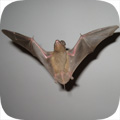 |
|
| Here is my best photograph of a bat in flight. I took this picture inside a customer's home. A bat had gotten inside the house, and was flying around and around. She hid in the kitchen as this bat circled the living room. I could have quickly netted the
bat, but I wanted to try to capture a good photo first. Bats tend to fly in repeated patterns. Even when they are outside and about the re-enter their home (your home, I should say), they swoop repeatedly in a patterned loop. This bat was doing the same thing. Thus, I knew
exactly where and when the bat would zoom by. On ...click for more |
02.10.2008 - Can Snakes Climb? Snake Crawls up a Wall
 |
|
| Many people ask me about the climbing capability of snakes. In particular, people want to know if snakes can get up into their attic. The answer is that
yes, some species of snake are excellent climbers, and can climb walls. But not just any wall. The snake must have something to grab ahold of and push off of. Not
even a rough surface will do - snakes can't "stick" to walls the way insects, rats, and lizards often do. The only times I've seen snakes climb walls are brick walls. I've
seen this a few times. The gaps where the brick meets the soffit also provide entry ...click for more |
02.08.2008 - Squirrel Nest in Attic
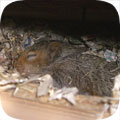 |
|
| Here are two separate photos of squirrel nests in the edges of attics. Squirrels most commonly make their nest at the edge, often down in the eave, or
soffit. Squirrels are less likely to run all through the entire attic the way rats do. They often just stick to the edges. Female squirrels have two litters
of baby squirrels per year. The first litter is in late winter, often in January or February. The second litter is in late summer, usually in August. Mother
squirrels seek out a high place in which to make a nest, safe from predators. Baby squirrels are very vulnerable. Sometimes ...click for more |
02.02.2008 - Ladder Work on Apartments
 |
|
| Most of my jobs involve ladder work. Except for cases of ground trapping, most cases of wildlife removal involve animals that have invaded homes or
buildings, usually the attics, and I need to address the problems high up, where the animals get in. This calls for ladder work. I carry three standard ladders on
my truck. One is just a 6' stepladder, which I mostly use to enter ceiling attic hatches inside homes. I also use it for work repairing under eaves of single story
homes, and other home repairs for which I only need a few extra feet of height. The second ladder is ...click for more |
01.25.2008 - Raccoons in House - Get them Out
 |
|
| People always ask me how to get raccoons out of the house. Raccoons are common nuisance critters in neighborhoods, and they often break into houses.
They have very little fear of people, and just want a nice place to live. Unfortunately, they can cause quite a bit of damage, in addition to noise. I've seen
raccoons in many areas of homes. They most commonly break in somewhere on the roof and live in the attic. I've also seen them live in eaves, inside wall cavities,
down in chimneys, and other parts of the architecture. Sometimes they even go into the ...click for more |
01.25.2008 - Pigeon Trap to Get Pigeons Out of a House
 |
|
| Pigeons are opportunistic animals. Like any animal, they need shelter, and the females seek out a safe place in which to raise young. Just
as is the case with raccoons, squirrels, rats, and other animals, pigeons have found that the attics of homes make an ideal place to live - they're safe from
the weather, dry, warm, and safe from predators. Thus, pigeons love to live in the attics of homes when possible. They need a certain amount of room in order
to enter and exit. In this case, it's a classic scenario. This house has a barrel tile roof, one of the eaves, ...click for more |
01.05.2008 - Norway Rat Control & Trapping
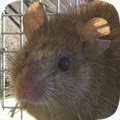 |
|
| Here is a photo of a Norway Rat (rattus norvegicus) trapped in a cage trap. I usually deal with Roof Rats in Florida. This photo was sent to me by my brother-in-law Sean, who operates his own wildlife removal business in Seattle, WA. He deals with more with
Norway Rats up there. Thought I trained him on Roof Rats down here in Orlando, most of the same principles and techniques apply to both rat species. These rats are by far the dominant rat species in the world, and both occupy a certain ecological niche and thrive as nuisance rodent
species worldwide. I will now exa ...click for more |
12.15.2007 - Raccoon Under House
 |
|
| Raccoons are opportunistic creatures who love to live in urban areas and neighborhoods. They take advantage of any space they can find a good, dry, safe
home. Trees are in short supply, but houses aren't! Many homes have raised decks or are elevated with crawlspaces underneath. Many wild animals are attracted
to such areas, which are protected from the weather. It's common for raccoons to choose to set up shop under the house. Most of the raccoons under homes are
solitary raccoons, or males. Female raccoons who have young like to ...click for more |
12.08.2007 - Florida Water Snake
 |
|
| Here is a fine specimen of a Brown Water Snake, (Nerodia taxispilota). This snake is supposedly common in some areas, but I've found only a few during my time as a nuisance wildlife trapper here in Orlando Florida. This snake is, like
pretty much all aquatic snakes, heavy-bodied in comparison to most snakes. Part of the reason for the body shape is because of the buoyancy needed for waterbound critters. I'm surprised that these snakes don't have any sort of a paddle-tail, but they don't. They swim
just fine, moving along the surface of the water via ...click for more |
11.11.2007 - Raccoon Drawing
 |
|
| A couple of years ago I rescued a baby raccoon, as I commonly do. I put the photos of this raccoon on my website, as I also commonly do. The photos are located here cute baby raccoons if you want to see them.
Anyway, a nice lady named Susan Smith wrote to me and asked if she could use my photos as inspiration to paint some wildlife pictures, and I said of course. I thought nothing of it until months later, when she emailed me a nice scan of a painting that she
made out of one of my photos. I have put her painting and the original photo side by side for compar ...click for more |
11.02.2007 - Rat Poison Is a Bad Idea
 |
|
| I say it again and again on my websites and in many of the blog pages that I've written about rodent control, but I just want to outline once and for all the many reasons why the use of rat poison is a terrible
approach to rat control. Poison is ineffective - Yes, poison does kill rats. But it does not kill all of the rats. Only 100%
eradication is acceptable in rat control. If you leave just a few, your problem is just as bad as it ever was, because rats reproduce so quickly. The thing about
poison is that not all the rats will eat it, and of those that eat it, not all will die. ...click for more |
11.01.2007 - Bird Spikes for Pigeon Repellent
 |
|
| Pigeons love to roost on store signs. This is a very common problem in urban areas. Signs such as the one in the above photo provide a
suitable ledge for the birds to establish nesting areas. Oftentimes these signs are in mini-malls or other areas with ready access to food, such as from nearby
restaurants and people. Of course, no shop owner wants pigeons roosting on his or her store sign. The birds make quite a mess with their nesting material,
feathers, and of course, droppings. You can see some small accumulations of pigeon poo on the sign above, and a lot ...click for more |
10.23.2007 - Bat Extermination
 |
|
| Today I went to a commercial building, a large department store, with thousands of healthy bats flying in and out. Months earlier, the store had hired their normal pest control company to take care of the bat
problem, and they sprayed the bats and the area with bug poison. I found about ten bat carcasses outside. Some of the old/frail had died. The vast majority lived, and the problem persisted, and so they decided to hire me
to take care of the bats correctly. Let me get it right out to anyone who found this post in a search for a means of bat extermination - AN ATTEMPT ...click for more |
10.22.2007 - Eastern Coral Snake
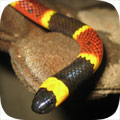 |
|
| This is a close up photo of an Eastern Coral Snake, Micrurus fulvius, that I caught. I'm holding it with thick
gloves. Yes, this snake is a member of the elapid snakes, a family that includes cobras, and it has a very powerful neurotoxin venom that can be fatal to people. However,
this snake is not very aggressive, and as you an see, it has a tiny mouth. It also has small fangs, and it can't inject venom the way the pit vipers do. The venom delivery is
slower. Thus, it's fairly safe to handle with thick gloves and a knowledge of how it can move and what it can do. I of course ...click for more |
09.26.2007 - Raccoon in the Soffit or Eave
 |
|
| Here's a photo that I took yesterday of a raccoon just as it was about to re-enter this house. You can see that it's torn open a hole in the soffit.
This is a very common entry point for raccoons. The eaves of the homes often meet other parts of the roof, and the soffit is right there. It's usually made of
flimsy aluminum or vinyl, and it's a cinch for raccoons to tear it open. This hole leads right into the attic of the home, where the raccoon has set up a nest.
Sometimes the raccoons live in the soffits or eaves themselves, or make their nest down in the soffit, where it's ...click for more |
09.22.2007 - Giant Rat - Big Norway Rat in Seattle
 |
|
| This photo was sent to me by my brother-in-law Sean, who I trained, and who now operates his own wildlife removal business in Seattle, WA. It's of a giant Norway Rat, or "hog rat" as he called it. I've gotten some very large rats myself here in Orlando Florida,
but none as big as this beast! Norway Rats are, on average, larger than the Roof Rats, or Black Rats, that I deal with. Most striking to me is the short, fat tail of this Norway Rat. Roof Rats have very long, black, sleek tails that are longer than the body length. This is probably
because Roof Rats require more balan ...click for more |
09.19.2007 - Pigeon Poop - Droppings & Waste in Attic
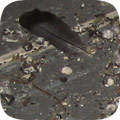 |
|
| I did a pigeon removal project at this residential house. The homeowner heard noises in the attic. At first he thought that he was hearing
rodents, such as rats or squirrels. However, one look at the evidence shown above, and I knew that I was dealing with a pigeon infestation. Pigeons love to
live in attics, just like other wild animals such as raccoons or mice. And just like any animal that lives in an attic, they leave their waste behind. In the
above photo, we see some of the remnants of the pigeon presence - the pigeon poop. As with any wildlife job, first thing ...click for more |
09.12.2007 - Dead Mouse in the House / Ceiling
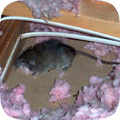 |
|
| Thanks to your website, I was given some good info
that allowed me to locate a rotting dead mouse in my attic. I was thrilled not to have to pay someone a
bunch of money to do it!I had to cut a hole in my hallway to gain access to
the space above the room where I had previously whiffed out the location of the carcass, just as you
described on your website. Making my way around the walls of the room we knew the smell was coming from, I
finally started on the ceiling and before long, GAG!!, I found the source, and it was just like you
said...leeching through the sheetro ...click for more |
09.09.2007 - Squirrel Detail Closeup Photograph
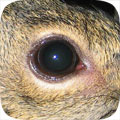 |
|
| This is a closeup photograph of an Eastern Gray Squirrel. I have it in a cage, and although it's hard to take good closeup pictures of squirrels, because
they are so rambunctious and fast, sometimes they will sit still for a period of time and let me take photos. This is a profile shot of the squirrel's head, with my close
camera setting. I have this photo in much higher detail than I posted here online, if you'd like a copy. Note how fur covers every surface, even the inside of the
ears. Also, you can see that it has whiskers, like all rodents. It's also got that tradmar ...click for more |
09.04.2007 - Opossum Teeth - Threat Display
 |
|
| Opossums have the most teeth of any mammal - 50 pointy teeth. When threatened, this slow critter often gapes its mouth open, exposing that mouth full of sharp teeth. It's just a threat display, however, and opossums very rarely bite. It's not that they
lack aggressiveness, it's just that they're too stupid to even manage a bite - seriously! They just stand there with their mouths open. I've shoved thick leather gloves and sticks into this wide open mouth, and the animal does nothing. It doesn't bite. I guess it's just
hoping that any aggressor will just back off at the sight of that ...click for more |
08.15.2007 - Bat Poop - Droppings & Waste in an Attic
 |
|
| The biggest problem with a colony of bats living in the attic is that they poop a lot. If the group of bats is very large, the waste can really build up.
Some colonies of bats are over 1000 members in number. Each bat makes about 6-8 bat turds per day. They live in the attic year-round. That means a lot of bat
crap. In the above photo, a small group of 40 bats were living in an attic. They roosted across the length of the attic ridge, but most of the bats roosted in one
area. Below that lay a pile of bat droppings, or guano, as seen in the above photo. This is a relatively ...click for more |
08.14.2007 - How Do I Get the Bats Out?
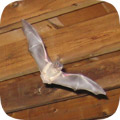 |
|
| Everyone always wants to know how I go about getting bats out of an attic. Well it's a trade secret, so bugger off! What I mean to say is, I trained for two straight years on bat removal projects, and the
variables in any particular job mean that there's no one way to tell a person how to do it. Basically, if you're a do-it-yourself type person, this isn't necessarily a do-it-yourself type project. Go ahead and rewire
your house - you don't need an electrician. Go ahead and cut down that tree - you don't need an arborist. Clogged arteries? Go to Sears and buy the triple bypass kit ...click for more |
08.08.2007 - Pygmy Rattlesnake
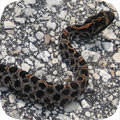 |
|
| Ah, the Pygmy Rattlesnake - one of central Florida's four species of venomous snake. It's supposedly the most common of the four, but I never find them.
I see more Cottonmouths, and I've even caught a few Eastern Diamondbacks and Coral Snakes. This snake is actually the Dusky Pygmy Rattlesnake, Sistrurus miliarius
barbouri. There's a few different species of Pygmies, and they live in the SE United States. I cannot determine if the proper spelling is Pigmy Rattlesnake or Pygmy, but both spellings are used
for the snake. Some people misspell this ...click for more |
07.01.2007 - Squirrel Cage - Trapped in a Cage Trap
 |
|
| Cage traps are a good option for squirrel control. There are lethal traps out there, but there's no need to kill squirrels. They can be live-trapped
and relocated. One-way exclusion doors also do a good job of removing squirrels from buildings, but squirrels sometimes then work to chew their way back into the
building. For successful trapping of squirrels in a cage trap, simply set the proper type of trap in an area you know the squirrels travel, and bait it with peanut butter
and peanuts or seeds. The trap must have the proper pan tension so that a lightweig ...click for more |
06.27.2007 - Eating Rats for Dinner
 |
|
| One of the perks of my job as a rodent removal specialist is that my work yields me free dinner. Some days I don't eat well, but tonight it's a feast! I caught eight plump and juicy rats today, so I'm in for a hearty meal. Many people ask me how I prepare the
rats for eating. Most people seem to think that I skin them, butcher them, and sautť the succulent rat meat in a garlic butter fry. Some have suggested that I probably stuff the rats, put a grape in their mouth, and bake like a turkey. When I caught rats in the Chinatown section,
it was implied that I'd stir-fry or ...click for more |
06.21.2007 - Baby Cottonmouth Photo / Picture
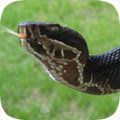 |
|
| This is an important snake to be able to identify in the state of Florida. This is a juvenile cottonmouth snake. As with many snakes, its appearance
is different from that of the adult snake. The young cottonmouth has angular brown and tan bands in a pattern. As the snake ages, these bands fade, and the snake
becomes almost entirely black. The only real identifying coloration marking on the adult is the black band that extends back from the eye. The cottonmouth. or
water moccasin as it's also called, also has an elliptical pupil (see the above eye, how it's cat ...click for more |
05.30.2007 - Eastern Glass Lizard / Snake
 |
|
| This is an Eastern Glass Lizard, (Ophisaurus ventralis), often referred to as a Glass Snake. It is actually a lizard,
but it looks of course, like a snake. It lives mostly in the SE United States, and throughout Florida. They grown up to about 30 inches long, and they eat mostly insects. They
spend much of their time underground, and that's where I caught this one. I was at a customer's house, sealing some holes near the base of the house, and I saw a little bit of
this lizard, and it went under the dirt, and I scrounged it up. I think it is pretty. This reptile got its name from the ...click for more |
05.23.2007 - Oppossum Capture
 |
|
| Oppossums can hang from their tails. In fact, their tails are prehensile, which means that they can curl their tails and grip objects. They
primarily use this feature to aid in climbing and balancing in trees. The truth is that they rarely actually hang from their tails. There's really no need for it.
However, they can do it if they must, perhaps to catch themselves from a fall. Thus, I am able to hold an oppossum by the tail with no harm to the animal. This
creature is fairly docile. I've seen very few aggressive ones. It's pretty safe to handle them this way. However, I wouldn't ...click for more |
05.18.2007 - Baby Armadillo Photograph
 |
|
| How cute! A baby armadillo! Armadillos aren't normally cute, but the younglings qualify, and then they get less attractive with age (like me!). Armadillos don't breed very often (like me!), and when they do, the young hide in the den and grow quickly. Thus, juvenile armadillos are
rarely seen or caught. However, today we got four juvenile armadillos. Here I am, seen holding the pick of the litter. How did we come across four in just one day? That's a silly question - armadillos ALWAYS have four young! That's right, in a very strange breeding quirk, armadillos
alwa ...click for more |
05.15.2007 - Flying Squirrel Removal
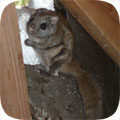 |
|
| Flying squirrels are rodents, like all squirrels. They don't actually fly, but glide on flaps between their front and hind legs. They are nocturnal
animals, and they are colonizing - they live in groups. They usually live in trees, just like the Gray Squirrels, but just like the Grays, they love to live inside of
attics. If you have flying squirrels in the attic, you will notice noise at night, since that's when these animals are active. They will leave the house at dark
and forage, and come back a few times, and retire by morning. They don't make quite as much noise as their larger ...click for more |
05.08.2007 - Vulture Removal & Control
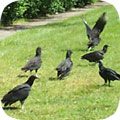 |
|
| Vultures! Those harbingers of death! Those dark-caped masqueraders of the other world! Those connoisseurs of roadkill! Yes, vultures.
These vultures in this photo are not Turkey Vultures Cathartes aura, but rather American Black Vultures Coragyps atratus which are more common
in the south. They are congregating around an armadillo carcass for unknown reasons. Ha, I always wanted to say that. They are actually there to eat the
armadillo carcass for the purposes of nutrition. When they eat the armadillo carcass, they will digest it and then later on they will poop...click for more |
05.06.2007 - Raccoon Removal Company - Wildlife Control
 |
|
| I am usually quite pleased with myself when I am able to find and remove a litter of baby raccoons from a difficult area. This type of work takes a lot of
sleuthing and searching. The customer had been hearing a lot of heavy scurrying and scratching noise in the cathedral ceiling in this room. I saw a big hole in the
roof, but there was no attic space for me to crawl in, because it was a cathedral ceiling (same slope as the roof, no real attic space). Thus, I had to very carefully
listen for any sign of baby raccoons. It would have been easy to simply set a trap and catch a ...click for more |
05.03.2007 - Dead Rat In the Attic - Remove Dead Rodent in Attic
 |
|
| This is a fairly common job: the dead rat in the attic. Rats are probably the most common animal to invade human dwellings (aside from humans, that is), and they have short
life spans and often live in high numbers and are persecuted with poisons and so on and so forth, and so they die inside buildings quite often. Since they tend to live in attics, they also tend to die in attics. Thus, the
most common dead animal removal job I have is the dead rat in the attic. I don't always know if it's a dead rat when I'm called to the scene, but once inside the building, I can definite...click for more |
04.14.2007 - Raccoon Tracks / Footprints
 |
|
| Here are a few different photographs of raccoon footprints that I've taken while doing wildlife control jobs. Raccoons have distinct tracks, and their
hands look somewhat like human hands, with a palm and long fingers. The hind foot of the raccoon is longer, but they tend to walk on the ball of the hind foot, so the
track often looks similar to the front foot. In the upper-left corner are some tracks inside an attic. They were on a section of sheetrock where there was no
insulation. There was a fine dust covering this area, so the tracks were very distinct. I actually saw this ...click for more |
04.13.2007 - Red Rat Snake
 |
|
| The Red Rat Snake (Elaphe guttata guttata), is one of the most common snakes that I find and remove in the Orlando
area. Like the Yellow Rat Snake, this snake is a constrictor that feeds primarily on rodents. And Orlando is chock-full of rodents! This snake will lie in wait for a rat to
pass by, or it will sneak up on a sleeping rat, and in a swift motion strike at the animal and wrap the rat up in coils, and suffocate it, then swallow it whole. Not exactly my
method, but nice rodent control nevertheless! I think that the Red Rat Snake is very pretty, with its orange and red pattern ...click for more |
04.04.2007 - Bats Out in the Daytime?
 |
|
| What are these crazy bats doing outside of the tile roof during broad daylight? Don't they know that the sun will turn them to dust? What could drive them out of their home and into the cursed light of Earth's
yellow sun? Could it be the result of... bat repellant? I know, I know, repellant is actually spelled "repellEnt". But a lot of internet users don't know that, and amazingly, more than a few find my glorious wildlife
blog by misspelling. Spelling is overated. Okay then, I'll answer the question: no, these bats were not chased out by any kind of magic bat repellent or deter ...click for more |
03.24.2007 - Cutting a Dead Squirrel Out of the Wall
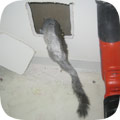 |
|
| I smelled a bad smell in this apartment, and I knew it had to be some dead varmint. I walked the house, employing a sniff. I entered the
laundry room and got a whiff. I sniffed the walls, I sniffed the ceiling, but it was the floorboard I found most appealing. I leaned on down and felt like
a hero, because I knew I'd found ground zero. I got my saw and cut out a square, and was promptly greeted with fragrant air. I reached inside and fished
around, and a squishy squirrel is what I found. I bagged it and tagged it and named it Muriel, I said a prayer & made a proper burial ...click for more |
03.23.2007 - Animal Hydration - Thirsty Armadillo
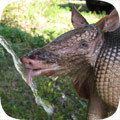 |
|
| Now here's a thirsty critter! This is a Nine-Banded Armadillo, after a day of being stuck in a trap. I usually work very hard to keep the animals cool. I set traps in the shade, I cover traps when I can, and I always retrieve the animals as early as possible.
The worst thing to do is to leave an animal in a cage all day, particularly out in the sun and without water! That is a very inhumane thing to do, and it causes the animal to suffer, and perhaps suffer heat stroke or death. It's important to get the animal removed and relocated
quickly. In a case in which I believe ...click for more |
03.17.2007 - Fight! Raccoon versus Opossum
 |
|
| Ladies and gentlemen! In the blue corner, weighing in at 11 pounds, making his debut fight, please welcome our challenger, Pete "I Don't Play Dead" Possum! And in the gold corner, weighing in at 14 pounds, our current champion, give it up for Ricky "Rocky" Raccoon! Touch paws
gentlemen, I want a good, clean fight! There's the opening bell, I expect they'll just look at each other as always AND HOLY CRAP THEY'RE ABOUT TO TEAR EACH OTHERS THROAT OUT STOP THE FIGHT STOP THE FIGHT, in goes the metal divider, and it's all over
a ...click for more |
03.16.2007 - Pigeon Disease - Diseases from Birds
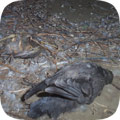 |
|
| Ever since I was a small lad, I was taught not to pick up bird feathers, as I was told they were dirty. Many birds are in fact dirty,
especially the "flying rat" or "gutter bird", also known as the pigeon. These birds often live in cities or buildings, and they make quite a mess with their
feathers, nesting material, and most of all, waste. The waste can accumulate in heavy amounts inside buildings, such as in the ceiling of the office
building pictured above. Here are some of the more serious diseases associated with bird infestation in public areas and buildings. The Histoplasmosis...click for more |
03.11.2007 - Raccoon Snare - Snaring an Animal
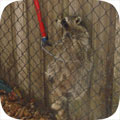 |
|
| Raccoon sure manage to get themselves into all sorts of trouble! This one somehow got itself lodged between a chain link fence and a wooden fence.
This was a really tight spot! I don't know how it happened, but this raccoon was stuck fast. We were called out to the scene. The easiest way to remove wild
animals from tight spots is usually with a snare pole - it's a pole with a plastic-coated metal cable that can tighten around the animal. Many animal control officers use
such a device. We were called out, and the property owner wanted the raccoon removed ...click for more |
03.05.2007 - America's Deadliest Snake
 |
|
| Behold! The most dangerous snake in America! The rare Hangman's Snake (constrictus dangleus). It sneaks up on you
from behind, latches itself around your neck, and then forces you to choke yourself to death! Sometimes this species gives you a chance to spell out a mystery word, but if you
fail to guess the correct letters and solve the puzzle, it attacks. If you spot this snake, stay calm and turn and walk the other way. It primarily lurks around gallows and
lynching trees, so beware when entering these habitats. Should you find yourself amidst an attack ...click for more |
03.04.2007 - Rodents Chew on Electrical Wires in the Attic
 |
|
| When I saw this wire, and several others with the same symptoms in this attic, I knew that I was dealing with some sort of rodent in the attic, and I suspected that I was dealing with rats. First of all, I saw the characteristic brown grease smudging on the wires,
which rats leave. Next, I saw many rat droppings around the wires. I also saw footprints that were clearly those of the Rattus Rattus, or Roof Rat. Finally, I saw chewing on the wire with the exact bitemarks that match the front incisors of the Roof Rat. Finally, I set some rat
traps right next to the offending wires, and ...click for more |
02.27.2007 - Raccoon Face Photograph
 |
|
| This is a photograph that I managed to take close-up of a raccoon. It was hiding in a duct, and I was able to get my camera very close. I caught this critter, so I know it was a female. But with raccoons, I can always tell anyway. Male raccoons
have a different appearance than females. The differences are subtle, but it's easy to tell, just like it's easy to tell with people. Female raccoons simply look more feminine, or even prettier, if you will.
If you spent as much time looking at raccoons as I do, you'd start to recognize the differences as well. A male has a somewhat wider ...click for more |
02.22.2007 - Do Bats Carry Rabies?
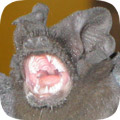 |
|
| Bats do carry rabies, as can most any mammal. Bats are of considerable importance, because they are common rabies vector species in North America. That is, most of the documented cases of rabies transmission in
the United States over the past 50 years or so are due to infection by bat. The number of cases is not high - I don't have the exact statistics, but I've read that there's about one death in the U.S. per year due to rabies
transmission from bats. This is much higher than from raccoons, skunks, or even dogs. The most likely reasons for this are ...click for more |
02.20.2007 - Squirell Control & Removal
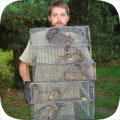 |
|
| I'm going to misspell squirrel as squirell for this blog entry, so that any internet searches searching for help with a squirrel problem might find this page.
Squirrels can cause many problem, but of course the most common is squirells in the attic. Some people have me trap and remove and relocate squirells just because they
are causing other problems outside, such as chewing on wood or stealing bird food, but most of the time, I deal with squirells inside homes. Most squirell control
revolves around trapping and removal. The nuisance squirells need to be tak ...click for more |
02.06.2007 - Armadillo Cage - Pet Armadillo?
 |
|
| The beautiful face of an armadillo. Just look at that snotty nose and those sharp claws! Who would't want an armadillo for a pet? Why,
you could just keep the armadillo in a cage or a pen, and it would be a fine and loyal companion, with all the benefits of a Golden Retriever, plus a tougher
exterior and barely any shedding. We should all have pet armadillos, right? Right. I mean wrong. I've received numerous requests over the years for armadillo
specimens to be donated as pets. The problem is that this animal isn't really suitable as a pet. At least, I don't think it is...click for more |
02.02.2007 - Animal Trapping
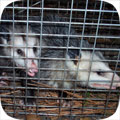 |
|
| Every now and then, while animal trapping, I get a double catch. Such was the case today, when I found two opossums in the same trap. While this was
a nice bonus, most of the time, I find no catches in my traps. Not that I'm a lousy animal trapper, but that this is the way it goes. Even the best trap set will
yield no results for a variety of reasons. Animal trapping isn't a simple matter, and a lot goes into successful trapping. I'll now outline the five primary
considerations when it comes to catching nuisance critters. Type Of Trap: Of the many wildlife traps available, ...click for more |
01.26.2007 - Pigeon Droppings & Waste in an Attic
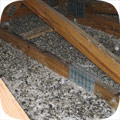 |
|
| Everyone knows that pigeons poo. You can see lots of their waste in any city in America, particularly under the areas in which they roost. However,
poop outside tends to wash away with the rain. In this case, pigeons were living inside an attic of a home, and it just doesn't rain as hard inside attics, and thus the
poop accumulated. This pigeon waste buildup happened over only a few months - or so I'm told by the customer, though the birds could have been up there longer than
suspected - and I found only five birds in the attic. I guess pigeons poop a lot! I flushed ...click for more |
01.21.2007 - Ringneck Snake Photograph
 |
|
| Here is a photo of me with a nice-sized Ringneck snake. I did not take this photo, as if often the case with photos in which
I appear. No, this photo was taken by the customer, who happens to be a professional photographer. Professionals shoot in black and white you know, which is much cooler than
boring old color. If the photo had been in color, you would have noticed the orange ring around the neck of this snake, its orange belly, and my shimmering olive green/grey
eyes, which evoke memories of the rugged Irish seas on an autumn morn. Alas, in this ...click for more |
01.19.2007 - Roof Rat Photo
 |
|
| I'm proud of this high-detail photograph that I took of a Roof Rat (rattus rattus). I caught this rat in a live cage trap, and decided that I'd do a photo shoot for the heck of it. I put the rat in the bottom of a tall white garbage can. Now, before you try
the same thing at home, I have to warn you that rats are amazingly fast, can climb almost any surface, and can really, really, really jump high. There's barely a container that can ...contain them. Only a tall unit with slick
vertical walls, at least four feet high, will do the trick. That's what I had in this case. Next, you want a rat that ...click for more |
01.14.2007 - Bat Control in Orlando, FL
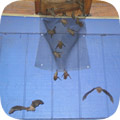 |
|
| I took this photo at a bat control project in Orlando Florida, where I live and work. It was a typical case of over 1000 Brazilian (Mexican) Free-Tail bats living in the attic of a building. I had to install
steel screens along all of the gaps around the perimeter of the structure. This case was a bit unusual in that the bats were willing to fly in and out of such large gaps. They usually prefer to fly in through tiny gaps,
often no more than a half-inch wide. I believe that the reason for this is, and I've never read any corroborating evidence to support this theory, but I believe the reason ...click for more |
01.13.2007 - Fat Raccoon
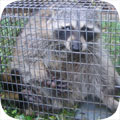 |
|
| This is one of the fattest raccoons that I've ever caught. Interestingly, in the cage on the left, out of the photo is the actual fattest raccoon that I
ever caught. However, I decided to feature only a photo of this one, because I like how it is sitting. It looks like a lazy blob, like Jaba the Hutt or something.
The one in this photograph weighed 22 pounds, and the one next to it was 29 pounds! These sizes are very large for Florida raccoons, which rarely exceed 15 pounds.
Up north, raccoons this size are more common, and can even reach up to 50 pounds, but in FL mamm ...click for more |
12.25.2006 - Christmas Squirrel - Ben Saves the Day
 |
|
| 'Twas the night before Christmas, when all through the house. A creature was stirring, a rat squirrel or mouse. The stockings were hung by the
chimney with care, but unfortunately of people the apartment was bare. The squirrels were all nestled all safe in their beds, while visions of peanuts danced in their
heads. Alas one poor squirrel did not make a peep, because it was stuck in a permanent sleep. Thus from the walls arose such an odor, that Ben jumped in his truck and
turned on the motor. The stench in the house from the walls that arose, gave the luster of ...click for more |
12.19.2006 - Squirrel Questions and Answers
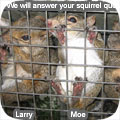 |
|
| Dear Three Squirrels, I was on your website and I had a question for you. How can I tell by sound if I have a squirrel or a mouse in my wall?
Some history: I have a new home. Itís only 4 years old and for the four years Iíve been in my home Iíve been plagued with critters in my wall. I know for a fact one of the nuisance was field mice. They would
come in late fall and leave late spring (every year). I believe I pretty much have that problem under control. I found some gaps that the builder didnít close (no roof sheeting behind the gutter in a couple of
spots, didnít caulk whe ...click for more |
12.18.2006 - How to Trap a Rat in a Cage
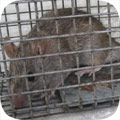 |
|
| Suppose you want to trap rats in a cage, as opposed to using snap traps. It can be done. I personally stick to snap traps most of the time, for a variety of reasons both practical and strategic. However, there are times when I do cage trap rats. The few times I've
done so have been by customer request. The principles for cage trapping are the same as for snap trapping. To trap a rat in a cage, set the cage in the right place. Rats tend to use the same paths and runways over and over again. These areas are easy to spot, because the rats leave
behind droppings, urin ...click for more |
12.11.2006 - Soffit Repair To Keep Critters Out of Attic
 |
|
| One of the most common areas that animals use to enter an attic is the soffit. The soffit is technically the bottom of the eave. Most homes have
aluminum or vinyl soffits, in track form, held in by J-channels affixed to the eave and the wall. Some homes have wooden soffits. Most soffits have some form of
ventilation - holes in the aluminum, or separate vents in the wood, or even a ventilation strip running the length of the soffit, with a screen. Most soffits are
vulnerable to animal entry, and given the architecture of a house, the eave leads right into the attic, where ani ...click for more |
12.06.2006 - Florida Brown Snake
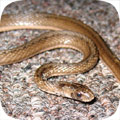 |
|
| The Florida Brown Snake Storeria victais is tiny, and it rarely grows to longer than a foot in length. It ranges throughout most of the Florida peninsula. It's not a very common snake, and because of its small size, boring brown color, and reclusive
nature, it's not commonly seen. It's a member of the common colubrid family of snakes, it's active during the daytime, it mostly eats bugs and little amphibians and reptiles such
as anoles, and it give birth to live young in the summer. It's not venomous. I caught this lovely specimen in one of my snake traps, ...click for more |
11.30.2006 - Guinea Hen Capture
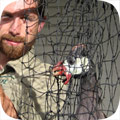 |
|
| Now here's a new catch! A Guinea Hen! I suspect that this fine bird was someone's pet, and then it either escaped or was abandoned. Either way, it wound up living on the steps at an apartment complex that I regularly service. This time, instead of
removing squirrels from the attic 3-stories high, I removed this feathery friend. Apparently the maintenance crew tried repeatedly to catch it and chase it away, but it stubbornly resisted capture and chasing, and had been living on a particular flight of stairs for
approximately a week, and thus I was called onto the sc ...click for more |
11.28.2006 - Green Anole
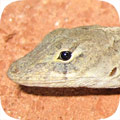 |
|
| The Green Anole, (Anolis carolinensis) is also called the Carolina Anole. It lives in the southeast US and throughout Florida. This small lizard can grow to about eight inches. Males are larger than females and have a throat fan, or dewlap. This lizard
can change color to match its background, and they eyes can move independently, like a chameleon. They eat a variety of small prey, mostly insects. If attacked, they can detach their tail in hopes that a predator will go for that as opposed to the more
vital parts. They can live up to seven years in captivity, but probably ...click for more |
11.25.2006 - Dead Animal Under the Floorboards
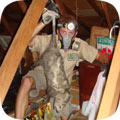 |
|
| "I have a dead rat in my ceiling", the call began. The calls usually do not begin correctly. "Okay, I will come to your house and remove the dead rat" I said. I don't bother to tell the caller that he is possibly
wrong. A bad smell in the home can mean a number of possibilities - 99% of the time it is in fact a dead animal. However, which animal might it be? Oh, this is where the delightful sleuthing and treasure hunt begins.
In this case, I entered the attic, and smelled it right away. Thus, I knew that it probably wasn't a rat. Rats tend to die under the insulation, and the smell per ...click for more |
11.19.2006 - Trapper Apprentice - Learning How To Trap Wildlife
 |
|
| I have a new apprentice training with me. His name is Ben, and already he's shaping up to be a fine wildlife removal specialist. He's demonstrated a
willingness to climb into hot attics, crawl under dirty homes, and sniff out dead animal carcasses. He doesn't mind getting his hands dirty, that's for sure! Here's
a list of the traits that make a good wildlife trapper apprentice: Common Sense - Probably the most important thing, outside of being a good person, and
not everyone has it of course. I don't care if someone has a fancy pants degree in wildlife biology. ...click for more |
11.12.2006 - Mummified Bat
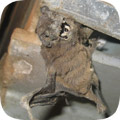 |
|
| Look at this fine looking fellow. It's a mummified bat. I've named him Gordon Marion Butler III for unspecified reasons. It was quite the delight to see this sight at night, when I shone my bright light just
right, it looks like it might take flight and bite. Oh, Gordon, you zany mummified bat. If anything, this specimen proves one thing - no, not that bats, Gordon in particular, are handsome, but that they can really cling to
stuff. I mean, if you expire and you're still hanging on for dear life, ur death, then you've got a good grip on things. Bats are downright sticky. I guess ...click for more |
11.04.2006 - How Do You Trap An Armadillo?
 |
|
| "How do you trap armadillos?" Many an exasperating phone conversation starts with this question on the other end of the line. Even though I have gone to great lengths to make it explicitly clear that I simply do not
want every yokel across the country calling me with nuisance wildlife questions - after all, when you call me, I WILL be engaged in one of the following activities: sleeping, driving, working on a roof, or working in
an attic - seriously, these are the only things I do. Sometimes I eat or type on my computer. Okay then, so I'm doing one of these things, when I get the ...click for more |
11.03.2006 - Raccoon Trouble Emails
 |
|
| Dear David- Greetings from Maryland. Your photos are dynamite and you certainly appear to be someone who is excellent in your profession, and enjoy the humane trapping and relocating of wildlife from domestic residences back to the wild.
We have been 'tracking' a raccoon(s) through our basement and in between first and second floor rafters for several weeks. This evening we successfully trapped an adult raccoon in a Havaheart trap and released it about 10 miles out of town in the woods.
The animal was unharmed in trapping, and appeared healthy, and ...click for more |
11.02.2006 - Removal of a Hawk From Aeropostale Store
 |
|
| I got a call today about a hawk stuck in a retail store. I arrived on the scene - a trendy shopping district in Orlando, and entered the address - an Aeropostale clothing store. Sure enough,
I saw a hawk perched amongst the rafters at the ceiling of the building (see upper left). Apparently the store managers had left the door open, and the bird was flying low and erratically because it was carrying its
favorite prey in its talons: a pigeon. Perhaps other pigeons were chasing the hawk (a behavior I've seen several times, once a hawk has a victim in its claws) & the hawk ...click for more |
10.25.2006 - Wildlife Relocation
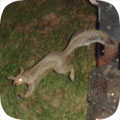 |
|
| Here is Tim, releasing some squirrels into a wildlife preserve area. These animals were caught and removed from an attic in a suburban home.
We perform live trapping and relocation of all our wildlife that we catch, so long as it's legal to do so. We always strive to put the animals under the least amount of
stress possible. We never leave animals in the sun, we don't leave them in traps for long, and we always relocate them same day. However, what is the right way to
relocate wildlife? It's possible that we are in fact putting them under a lot of stress by tak ...click for more |
10.22.2006 - Florida Scarlet Snake
 |
|
| This is a Florida Scarlet Snake - Cemophora coccinea coccinea. They're not terribly common here in central Florida, at least as far as I've seen. This is probably because they're primarily nocturnal
and spend most of their time under heavy debris and rocks and other cover. This snake is not to be confused with either the Scarlet Kingsnake or the Coral Snake. Regarding the latter, the venomous one, it's important
to realize that the Scarlet Snake is a harmless mimic, and is, in my opinion, very ...click for more |
10.11.2006 - Wildlife Rescue in Orlando Florida
 |
|
| If you are seeking wildlife rescue for a wild animal in Orlando, you probably won't get free help to rush on out and take care of it for you. There are some wildlife rehab centers and individuals operating in the Orlando area, but
they don't do house calls. You have to bring the animal in to them. One of the frustrating aspects of running my own wildlife removal business is that many people call me thinking that I'm some government sponsored agency, and that I will come to the
property for free to take care of some wildlife malady. Many of these callers assume that the ...click for more |
10.10.2006 - Florida Exotic Species - Iguana, Burmese Python
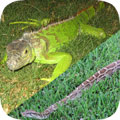 |
|
| One of the more common sensationalist topics in the field of wildlife management is that of exotic species. Exotic means non-indigenous, or non-native species. In particular, people are interested in large and scary critters such as giant lizards and snakes. In my field of nuisance wildlife control, I come across exotics commonly. The above photo shows two of the interesting exotics that I've dealt with over the years: the iguana, which is native to Central and South America, and the Burmese Python, which comes from southeast Asia. I caught these animals in suburban ...click for more |
10.05.2006 - A Nest of Baby Rats
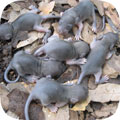 |
|
| This is a litter of baby rats that I removed from the gutter of a home. The homeowner had actually observed the female rat entering and exiting the gutter, and suspected a nest therein. I arrived at the home,
and found the gutter of the porch roof completely littered with years' worth of debris, much of which was so old it had nearly decomposed into soil.. I began to dig through and remove and bag the debris, when one of my
scoops yielded a SQEAK- SQEAK- SQEAK noise, and I knew I had hit paydirt. By paydirt I mean rats in dirt, for which I got paid. I carefully ...click for more |
10.03.2006 - Preventing Squirrels from Getting in the Attic
 |
|
| Here's a couple of squirrels that I've managed to photograph inside attics. I've already written many guides about how to remove squirrels from attics, so
now I will just write about how to prevent squirrels from getting into your house in the first place. Of course, if you've found my website, it's likely that you already
have a wildlife problem, but I'll write about prevention anyway. If your already have a squirrel problem you can certainly do preventative measures to prevent future problems
from happening again. Step 1 Inspect the whole house, top to bottom, and ...click for more |
10.01.2006 - Brown Water Snake
 |
|
| I caught this Brown Water Snake, Nerodia taxispilota, on the shores of Lake Maitland, FL. Many people confuse this snake with the
venomous Cottonmouth, or Water Moccasin. The Brown Water Snake is, of course, an aquatic snake, just like the Cottonmouth. Most aquatic snakes have bulky
bodies. And of course pretty much all snakes have triangular heads larger in size than their necks. Thus, this snake does mimic the body shape of the
cottonmouth, in addition to sharing its habitat. However, the snake is not venomous. It does give birth to live young ...click for more |
09.27.2006 - Florida Armadillo Control
 |
|
| Here's a nice blurry shot of my friend Tim and I with some armadillos that we caught today. They've been very active lately, digging large burrows under homes. Most armadillos that I deal with tend
to dig underneath homes. However, in this particular case, the armadillos were digging under a deck. They must have moved about 500 square feet of dirt in this case. The mound of sand/dirt outside the tunnel was simply
huge. We had to work to climb over it. The homeowner didn't want the armadillos because they removed so much dirt out from under the deck, and the ...click for more |
09.25.2006 - How To Catch Squirrels
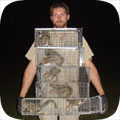 |
|
| The best way to catch squirrels is with a cage trap. There are lethal traps available, but there's no need to kill squirrels, and lethal traps are
dangerous to use, and in my opinion, less effective than cage traps. In the above photo, I'm holding three types of cage traps. The two traps on top are Havahart
1045 traps. They work well, but they are limited to flat areas with enough room. The door slides up vertically, and it needs enough space. It comes down due
to gravity when a squirrel steps on the trip pan and a bar triggers the door to slide down and shut. The next two pict ...click for more |
09.24.2006 - Ugly Opossum
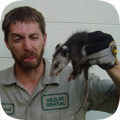 |
|
| Some people think opossums are cute. Some people think they are ugly. In the case of this specimen, it's the folk in the ugly camp who are correct. This possum so ugly when it joined an ugly contest, they said "Sorry, no professionals." This possum
so ugly just after it was born, its mother said "What a treasure!" and its father said "Yes, let's go bury it." This possum so ugly its fleas wear paper bags over their heads. I showed this photo to a friend of mine and said how ugly it was, and she agreed that the subject
wasn't very cute, but that the critter looked fine, and I didn't ...click for more |
09.22.2006 - Wildlife Jobs in Florida
 |
|
| If you are seeking a job working with wildlife in Florida, there are several options. You can work for a local county animal services, where you will deal mostly with dogs and cats. You can work with the Florida Wildlife Commission, where you
will probably not get a job, and if you do, it'll probably be something specialized, or perhaps a desk job. I'm not sure. Contact them at www. floridaconservation .org. You can also seek to be employed by a
privately owned wildlife removal business. There are several such businesses in Florida, such as (names altered) Kritter Kontrol, Trap ...click for more |
09.21.2006 - Rat Catching - How to Catch a Rat
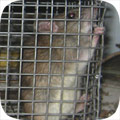 |
|
| This job took place in the ceiling of a church. The man who hired me was not the minister, or the organist, or the acolyte, or the little old lady with the blue hair who never misses a Sunday. I'm not sure exactly what he was, but he's probably the creepiest
customer I've ever had to deal with, and he told me to catch rats and squirrels from the attic. So I did. The attic of this church did have a major infestation of both rats
and squirrels. The people inside the church could hear them all the time. The attic was filled with rodent droppings. Because of the presence ...click for more |
09.20.2006 - Florida Ringneck Snake
 |
|
| The Florida Ringneck Snake is one of the most commonly removed nuisance snakes in the state of Florida. Of course, it's as harmless as an
earthworm. The reason I encounter this snake so often is because it is not only common, but small - and thus it commonly squirms through very small gaps and
into houses. It is the single most commonly encountered snake inside the home here in FL. Snakes explore their habitat, and often squirm through small gaps,
and thus it often finds small holes under doors or other areas, and slithers into a house, and then can't find its ...click for more |
09.18.2006 - Coonskin Cap
 |
|
| I wanted to wear a coonskin cap, to imitate Davey Crockett. I wondered if I should set a trap or pay for one out of pocket. If I bought the hat, what's the sport in
that? And what about my wallet? Shell out the scratch, or make a catch - it's heads or tails - you call it. If I set a trap and caught a coon, then I'd have to skin it. That'd make me feel like a goon. I thought it
over for a minute. What if, I thought, I made the catch, thus saving me some dinero? But then I chose not to dispatch, Thus making me a hero? Ah, I thought, now that's the ticket, have my cake and eat it too. So I ...click for more |
09.11.2006 - Baby Coral Snake
 |
|
| This is a juvenile hatchling Eastern Coral Snake. It's probably a month old at most. Whereas some snakes will constantly slither all over the place, corals will often hold still in one position. I was in a good mood,
so I decided to drape it over my nose. I sent this photo to a friend, who claimed that I must be crazy, as he had heard that the venom of juvenile snakes is more potent than that of adults. I replied that I do not
think this is true. The composition of the venom does not change over the lifetime of the reptile. Although it's true that the neurotoxic venom of the Coral Snake ...click for more |
09.09.2006 - Critter Catcher in Training
 |
|
| Ah, yet another disgruntled software engineer who's decided to take a walk on the wild side. I myself used to be a software developer, hating my life
behind the desk staring at a computer screen (oh wait, that's what I'm doing at this very moment), but when I discovered the fun of working outside catching critters, I haven't
looked back. My friend Tim decided that he'd like to do the same thing, so now he's down here with me in Florida, training to be a critter catcher himself. He wants
to open his own operation in Portland after six months or so with me. Tim is one of ...click for more |
09.07.2006 - Pine Woods Snake
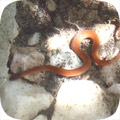 |
|
| This is a Pine Woods Snake, (Radinaea flavilata). It is an uncommon snake. It lives throughout most of the Florida peninsula and spotty areas throughout the SE coast, but it's not very common. It's an orange/rust/pinkish colored snake that
spends most of its time under debris, eating bugs and little lizards and stuff like that. It rarely grows to more than 14 inches, and this one was about 10 inches. The only reason I'm even bothering to write about it is because it was a new snake find for me.
It looks similar to the SE Crown Snake or the Florida Brown Snake, both of which ...click for more |
09.05.2006 - How To Remove Cats in the Attic
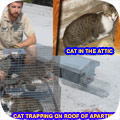 |
|
| Cats in the attic! Cats in the attic! All I keep hearing about is cats in the attic. Meowing and scratching! Prowling and mouse catching! Howling and rat snatching! Well, not howling so much. But yeah, cats in the attic. I remove
all kinds of wild animals from attics: raccoons, squirrels, opossums, rats, bats, and even cats. Most of the time, the customer hears scratching and scampering and clawing in the attic. But sometimes they also hear mewing. If they hear mewing, I have reason
to suspect that they have cats, for cats howl and mew. If they do have cats, what ...click for more |
09.03.2006 - Florida Pigeon Control
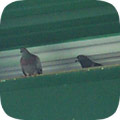 |
|
| This is a typical example of a pigeon problem at an urban building. In this case, it was an auto repair shop in Orlando. I have split the
photo into two parts - on the top is the area where the pigeons roost on steel beams below a metal roof. Below is the ground that is covered with pigeon
droppings. The owners of the auto store clean the droppings often, but the birds keep making a fresh mess all the time. Pigeons are a common problem bird
in Florida. Specifically, the urban pigeons that cause these problems are often called Feral Pigeons or Rock Pigeons, and even ...click for more |
08.24.2006 - Orlando Rattlesnake
 |
|
| Here's an Orlando Rattlesnake - With diamonds on its back - Please, dear reader, make no mistake - It has a most deadly attack
- It's armed with hypodermic fangs - And a nasty disposition - Upon my trusty hook it hangs - In a compromised position - But if you see it on the ground - And if you get too
close - Soon, my friend, you will have found - Yourself with a lethal dose - You may have seen the warning signs - The coiling and the rattle - Because before this serpent
dines - Its tail begins to tattle - Let that serve as ample warning - For you to back away - Wake up ...click for more |
08.20.2006 - Groundhog Trapping
 |
|
| Groundhog trapping, in Florida of all places? No, I have to admit that I did not trap this groundhog at all. It was captured by my good friend Bruce, who lives on Massachusetts. The critter was digging under his porch and eating his plants, and
he finally decided that it had to go. He called me to ask for my expert advice. I carefully described a trap consisting of an apple under cardboard box propped up by a stick to which a string is tied. Bruce is so trusting, that he set up said configuration, and waited
many frustrating hours patiently waiting for the groundhog ...click for more |
08.16.2006 - A Giant Colony of Bats in the Attic
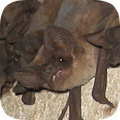 |
|
| Sometimes I see a case of wildlife gone wild so severe, that I wonder what the devil the homeowner was thinking. It's like the guy who sits down in the dentist's chair and has 16 cavities in the seven teeth
he's got left. Why was it not addressed earlier? I encountered such a case today when I came upon a large colony of bats living in an attic. This is a colony composed entirely of Brazilian Free-Tail bats. I estimate
the size of the group in the range of 1500-2000 members. The full photo apparently contains 91 individual members (according to my expert bat counter). ...click for more |
08.12.2006 - Removal of a Dead Opossum in the Wall
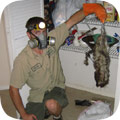 |
|
| I liked this job. I was called to this house due to the horrible odor. Sometimes the dead animal odor is faint, and this one aint.
What's the past-tense of aint? Waint? Anyhow, as usual, I sniffed and I snuffed, searching for the dead animal. I had no attic space to investigate, so I
had to keep my nose on the walls. The smell was strongest in the kitchen. It's usually pretty hard to pinpoint dead animals inside walls. But I'm really
good at it. I found the wall with the strongest odor, and as luck would have it, I could make my incision from inside the kitchen closet, thereby making...click for more |
08.01.2006 - How To Get an Animal Out of a Tree
 |
|
| The man in this photograph is not me. In fact, it might not be a man at all - more like a monkey. I'd never make a climb this high or dangerous, let
alone with a snare pole in hand, let alone back down with a struggling raccoon on the end! But that's what my friend Sean did to catch this raccoon in a tree. The
customer called because this particular raccoon has been causing trouble. Breaking into the attic, tipping over the garbage can, and always out and about during the day
threatening her dogs, and so on. So when she saw it, Sean came out to catch it, and it ran up a ...click for more |
07.27.2006 - Cuban Tree Frog in Florida
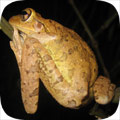 |
|
| These frogs are everywhere here in Orlando Florida. When I arrive at a house, I often see them perched on the walls or atop the door, or light fixture, or many other areas. When I conduct an inspection of the roof, I often find several more. I routinely
see them down inside the plumbing stacks of homes. For the most part, they are harmless. However, some people simply don't like frogs, or even have phobias, so from time to time I am called to address frog issues. I've had a couple of cases of frog-in-the-toilet, and I
think that the frogs may have gone down the ...click for more |
07.26.2006 - Snake Eating Squirrel
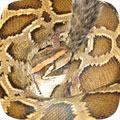 |
|
| I caught this eleven foot Burmese Python yesterday. I was also called to remove a freshly killed squirrel today. I noticed
that the snake was rather thin, with ribs showing and everything, so I figured, "why not?" and I threw the snake the squirrel. I've never kept snakes before as pets, nor do I
know anything about feeding snakes. I left the room and went to do some computer work, and when I came back to check, it was swallowing the squirrel! I took this photo of the
process. The snake had wrapped all around the animal, and was just slowly swallowing it. It was fascinating ...click for more |
07.25.2006 - Burmese Python in Florida
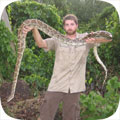 |
|
| This is the largest snake that I've ever caught as a wildlife control operator. At 11 feet in length, it's the longest animal that I've ever caught as well, even longer than that ten foot squirrel I once got. This is a Burmese Python
(molurus bivittatus). It's native to the rainforests of southeast Asia. It's one of the largest species of snake in the world, and the largest known specimen so far is 27
feet long and 400 pounds. I guess that makes the one I just caught seem small, but still, that's one big snake that I caught. I got the call from an apartment complex, and the
snake was actually ...click for more |
7.18.2006 - Attic Cleanup - Remove Wildlife Waste & Poop
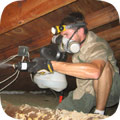 |
|
| In the above photo I'm spraying the attic with my atomizer to destroy the animal waste. I usually wear a biohazard suit, but this attic was about 150 degrees in the Orlando July, so I skipped it. Not a good idea, but I showered immediately afterward, and I always wear my HEPA filter mask. This attic had rats, and the brown chipped insulation, which meant that I couldn't see all the droppings very well, nor vacuum them. This fogging machine, also called an atomizer, sprays my cleaning solution in a fine mist that permeates the entire attic, and makes certain attic cle ...click for more |
07.12.2006 - Chicago Raccoon Job Emails
 |
|
| Dude, your site is awesome and helped me SO MUCH. I just did get rid of a raccoon in an attic above my kitchen. We used a live trap and some tuna and caught it and then took it over 10 miles away and released
it into the forest preserve. I am in the process of looking for a company to go up in there now and remove all the insulation and shit that this thing left up there. I was considering putting on a mask, gloves and going up there and doing it myself, but after
reading your site I'm thinking maybe I should let professionals do it. YOU HAVE BALLS man. lol Some of ...click for more |
07.11.2007 - Tokay Gecko In Florida
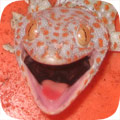 |
|
| We got a call about a very strange sound that came from the walls of a home every night. We get calls about animal noise all the time - that's usually the first symptom of animal infestation that people notice. However, most of the sounds are standard
scurrying or scratching in the attic. Sometimes people hear running on the roof, and sometimes they hear the chattering of baby raccoons. However, in this case they heard a loud croaking/squawking sound and a tooting not unlike a kazoo. It was driving them crazy and keeping
them awake all night. At a loss for wh ...click for more |
06.29.2006 - Chimney Swift Removal
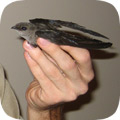 |
|
| Each June, I receive many calls about a terrific racket coming from inside a chimney. I've heard all sorts of explanations, everything from "family of squirrels" to "there's a rattlesnake in my
chimney!". These explanations are wrong. It's Chimney Swifts (Chaetura pelagica). The Chimney Swift is one of North America's more remarkable birds. They are fantastic fliers: they catch their food, insects, on the wing,
and even snatch up nesting twigs on the wing. They use these twigs to build a nest, which they adhere to the wall of a cavern using special sticky saliva. In nature ...click for more |
06.27.2006 - Mouse Nest In Attic
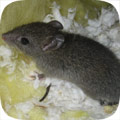 |
|
| One of the reasons rodets such as rats and mice enter an attic is in order to have a place to create a nest and have babies. This is actually the primary reason certain animals, like raccoons and opossums use attics. Rodents tend to use attics regardless, but
as with any animal, they create their nests in convenient and safe places, so if you have rats or mice in your attic, there's a good chance that some of the adult females have created nests. I've seen several different rat and mouse nests in attics so far. The nest usually
consists of a cluster of shredded debr ...click for more |
06.21.2006 - Attic Insulation Replacement Vacuum Cleanout
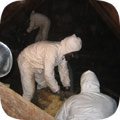 |
|
| I visited my friend Matt in Massachusetts, and he brought me to one of his attic cleanout jobs. This attic was filled with bat droppings, or guano, due to an infestation of Big Brown Bats. It's important to remove the droppings, because they not only smell bad, but can grow mold over time, mold that can cause lung diseases for the inhabitants of the house. The insulation in the attic was also sub-par, so Matt decided to remove all of the droppings and insulation, clean the attic, and add new insulation. I helped out on the day that we removed the droppings and insulation. ...click for more |
06.17.2006 - Nine Banded Florida Armadillo
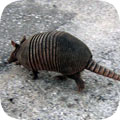 |
|
| Today I happened across one of Florida's more unusual creatures, the Nine-Banded Armadillo (Dasypus novemcinctus). It was crossing a parking lot. Instead of running it over with my truck, I decided to photograph it. It
was making pretty good time for an armadillo, purposefully striding across the pavement. Usually they slowly root along, sniffing for snacks to dig out of the ground. However, this armadillo must have sensed that it
would have difficulty digging through the pavement, so it decided to trot along to softer pastures. Since I've already explained why armadillo ...click for more |
06.15.2006 - Dead Baby Oppossums In Wall
 |
|
| First of all, I know that opossum is spelled with one "p", but a lot of internet searchers don't know this, so I decided to spell it with two p's, as
in oppossum, or even opposum, which is also another common misspelling. Regardless, on this day, I removed three dead baby opossums from inside a wall. As usual, I
entered a home that had a bad odor. I took a cursory stroll around the home in order to gain a sense of the area of strongest odor. I isolated it to a room or two,
then jumped in the attic to look. Most commonly, the dead animal is somewhere in the attic. I ent ...click for more |
05.30.2006 - Eastern Garter Snake - Not Garden Snake
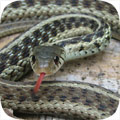 |
|
| The above photo is of an Eastern Garter Snake, (thamnophis sirtalis). This snake is possibly the most commonly sighted
snake in North America. There are many variations of Garter Snake, and the colors and patterns can vary, but for the most part, it's a slender snake with a triangular head,
usually has some form of dark green and tan, and three stripes down the length of the body, on on top and one on each side. This snake is not venomous, and it's the exact same
species that I used to find and pick up and put in a jar and show to my mom for her praise and ...click for more |
05.22.2006 - Baby Bat - Evening Bat
 |
|
| This is a photo of a juvenile bat. The species is Evening Bat. The females usually give birth in mid-April, so this specimen is probably about five weeks old. I found it exactly as photographed here, lying on
its back on the kitchen floor. I hadn't handled a baby bat before, as I do no bat work during the summer maternity season, when the young bats are unable to fly out of the house and therefore unable to fly out of my one-way
bat exclusion nets or funnels. However, in this case the baby bat had wandered down from the attic, through the walls, and out into the house, click for more |
05.21.2006 - Evening Bat Closeup
 |
|
| This is a close-up photo of an Evening Bat - Nycticeius humeralis. I found it in a home here in Florida. It had been living in the attic of the house with the rest of the colony, but a baby bat, possibly
its own, got separated and crawled down the walls of the house, and out into a gap next to the oven vent, and into the kitchen of the home. The adult female bat chased after it, and ended up in the home as well. Once
inside, it had no idea how to get out, and was stuck. I was called by the terrified homeowners and when I arrived, the bat was lying down, exhausted. ...click for more |
05.18.2006 - Pueblan Milk Snake
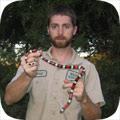 |
|
| I received a call about a Coral Snake in someone's patio. Red, black, and yellow bands, I was told, along with a black nose.
That's a sure description of a Coral, and out I sped to remove the dangerous snake. I showed up to the house, but as is often the case, the snake had left by the time I
arrived. I hate that. I had to drop everything and make a long drive out to the house, and now it had vacated. I scrounged around inside the patio and found nothing, and so
I concluded that it must have slithered out the same way it came in, probably through a gap under the patio ...click for more |
05.10.2006 - Raccoon Bait - What Foods Catch Raccoons?
 |
|
| This blog entry is about what bait is best to trap and remove nuisance raccoons. If you are merely interested in feeding local raccoons, please, PLEASE do
not feed the wildlife. It is a lot of fun and it feels good to do, but it WILL result in animal suffering - critters dependent upon people, increased spread of disease,
unhealthy animals, and starvation when the food source is inconsistent or stops. If you want to know what food to feed a baby raccoon or pet raccoon, I don't advise
keeping them as pets, nor am I an expert in that matter. I'm often asked what bait ...click for more |
05.02.2006 - Tile Roof Repair - Roof Rat Prevention
 |
|
| This was a difficult job. It was a large house with a roof rat problem. The only way to permanently get rid of rats is to seal off all of their entry
holes. This is one of the most difficult types of homes in which to solve the rat problem, because it has a barrel tile roof, and not just that, a barrel tile roof with an open
perimeter. That means that around the edge of the roof are open gaps under every last tile. Rats can enter these wide-open areas at will, and run underneath the
"tunnel" under the tiles and find any opening into the attic, such as where plumbing stacks go through the ...click for more |
04.29.2006 - Florida Black Racer
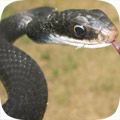 |
|
| Ah, the Southern Black Racer, (Coluber constrictor priapus), the most common snake that I deal with here in Orlando Florida. I estimate that about 40% of all snake calls that I get are due to this one species of snake alone. They are simply
very capable snakes, good at surviging, and they can adapt to a wide variety of habitats. Whereas other snakes inhabit more specific ecological niches, or simply need just the
right protection, Black Racers do fine in a variety of habitats, including suburban and urban. One often has to travel outside of developed Orlando to ...click for more |
04.26.2006 - Raccoons in the Porch Stealing Pet Food
 |
|
| One of the common complaints that I hear from customers is that raccoons are feeding on pet food left outdoors. Duh! If you leave food outside,
animals other than Spot and Fluffy are going to find and eat it. The simple solution, I tell such people, is to take the food indoors, especially overnight, or make sure
that the pets eat all of it. If you do take the food indoors, don't leave it adjacent to a pet door or in a screened-in porch. Raccoons will still be able to smell
it, and now they will break in to get to it. That's what happened at this job today. These two young raccoons ...click for more |
04.24.2006 - Corn Snake
 |
|
| The Corn Snake, Elaphe guttata guttata, is probably the 2nd most common snake that I find and remove here in Central
Florida. I consider it the prettiest snake that I deal with. It has a beautiful red and orange pattern, and the belly is white with black keyboard markings, from which it
gets its name (apparently the markings look like maize, although I'd have named this snake the piano snake on the basis of its belly). Many people associate brightly colored
animals with poison, and it's true that many critters in nature that choose to stand out via their coloring, which is ...click for more |
04.21.2006 - Horrible Smell Inside of a Building - How to Get Rid of Bad Odor
 |
|
| This was an interesting job. I perform dead animal removals on a nearly daily basis. The jobs are always the same - someone calls me with a horrible odor inside the home or
building, and suspects that it's a dead animal carcass, and they call me out to address the problem. Most of the time it is a dead animal. However, every now and then the odor is from a different source. Sometimes it's
rotting meat - such as the bag of rotting hamburger meat I once found on top of a fridge, the rotting chicken I found behind a stereo, or the rotting and forgotten steak inside a micro...click for more |
04.20.2006 - Snake Removal at Carrot Topís House
 |
|
| This was actually my second time to this customer's house in Winter Park, part of Orlando FL. Both times his assistant and
himself referred to him as Scott, but I recognized him as the prop comedian who goes by the name Carrot Top. I guess he's kind of hard to miss, and the walls of his house are
adorned with various Carrot Top propaganda. My first call to his home came because he had a terrible odor in his house. I knew that it was a dead squirrel. His house was large
with a very complex architecture, and the area of the attic above the room with ...click for more |
04.16.2006 - Female Opossum With Babies on Her Back
 |
|
| This is one of the things that opossums are well-known for. A group of baby opossums clinging to the back of the mother opossum. This kind of thing is common at this time of year, mid-April, because the female possums have their young in the late winter and early
spring, and by this point, the young are grown to a size large enough to spend most of their time outside of the pouch and clinging directly to the back of their mother. It's actually an interesting game of survival. The female opossum has 13 nipples. So at the very beginning, there's
competit ...click for more |
04.05.2006 - Removal of a Critter in the Attic
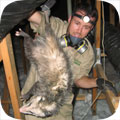 |
|
| Sean and I went to this home today because the customer was hearing noises above his head, and he suspected that he had a critter in his attic. We climbed
the garage ladder hatch and entered the attic, with gloves, headlamps, and dust masks, as usual, and began our inspection. We found plenty of tracks and opossum
droppings, so we knew what critter we were dealing with. Most of the time, we never actually spot the animals in the attic. They quietly hide in the deepest darkest
corners when they sense a potential danger, and they are tough to find. So that's ...click for more |
04.04.2006 - Bat Droppings & Histoplasmosis
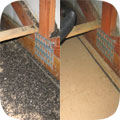 |
|
| Do bat droppings carry the fungus that causes the lung disease histoplasmosis? They certainly can, but it's not as common as some bat removal companies might have their customers think. While it's often
better to err on the side of caution when it comes to biohazards and human health, it's also important not to get carried away. Look at the before and after photo here. This is considered a very minor case of bat
droppings - from a small colony of bats over a short period of time. This accumulation is very unlikely to harbor any fungal growth. The best of ...click for more |
04.03.2006 - Toad Mating
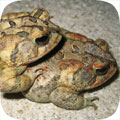 |
|
| I found these fine toads while working in a bat removal project in Heathrow, FL. I don't know what species of toad they are. They're not the regular Eastern Toad, even though that's what they look like, since the range of that toad does not extend
to Florida. I liked how these toads were clearly good pals. They were nearly inseparable. At one point they actually tried to play a game of leapfrog! However, the one frog couldn't quite hop over the other. He tried and tried, but just couldn't make it. The
other frog didn't seem to mind.* Anyway, I took these in-good ...click for more |
04.02.2006 - Little Raccoon
 |
|
| No real point to this blog post except to show off this cute photo of Sean with an adorable little raccoon. It was one of a litter of baby raccoons,
perhaps six weeks old, that we removed from an attic earlier today. We are keeping them in a box, and feeding them kitty formula, and then tomorrow we will bring them to
Lee the wildlife rehabber, and she will raise them until they are large enough to fend for themselves. Raccoons like this one are almost hypnotic in their captivating
power to leave their handlers entranced for hours on end, with their little black masks and ...click for more |
04.01.2006 - Dead Florida Wild Hog in Orlando
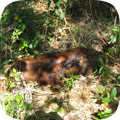 |
|
| I was driving along, singing a song, when suddenly I had to stop driving. For I noticed a scent, and I was hell bent on doing some dead
animal diving. By dead animal diving, I don't mean leaping headlong into a carcass - I mean investigating and photographing the scene of the crime. I got
out of the car and found this wild pig carcass. I suppose, thinking about it now, that this isn't all that interesting. However, it's the only evidence I
have as of now of a wild hog. Sure, I've seen the destruction they cause. They absolutely decimate a lawn when they root through ...click for more |
03.31.2006 - Bat Guano Cleanup in Attic
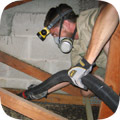 |
|
| Today was the cleanup of bat droppings (guano) from the attic of a home. The cleanup is the final step after all of the bats are safely removed and all of the entry points through which the bats could enter the
home are permanently sealed. This was a very simple cleanup case, and not at all bad contamination. First of all, the effected area was above a garage, so I didn't have to deal with any insulation removal. The droppings
were all on the sheetrock. Furthermore, the colony was small, and hadn't been in the attic for long, so the droppings had not accumulated yet. It ...click for more |
03.27.2006 - Baby Possum
 |
|
| I made a baby possum sighting, so I grabbed it and got some fighting, both with scratching and with biting, so now I'll do some possum writing. Baby possum on my shoulder, he is young but I am older, I am shy but he is bolder, my shoulder is a possum holder. Baby possum climbs on me, I am big but he
is wee, he is too young to be set free, he and I will drink some tea. Baby possum tiny tail, tiny hands sized to scale, little bones are thin and frail, he does not
belong in possum jail. Baby possum is a clinger, he hangs around upon my finger, from his tail he is a sw ...click for more |
03.26.2006 - Snake in the House - How to Get it Out
 |
|
| "EEK!! A SNAKE IN MY HOUSE!!" *faint - This scene plays itself out every day in America. A hapless homeowner turns the corner
into the hall, spots a snake lying about, lets out a high-pitched scream and collapses, and then his wife has to come and resuscitate him, nurse him back to health, and send
him off to counseling to get over this traumatic event. The wife then gets the broom and sweeps the snake out the door, and the problem is solved. I deal with snakes inside
homes almost every week. I've seen several different species. In general, the more ...click for more |
03.26.2006 - Squirrel Traps in Action
 |
|
| Here's a fine day's catch of squirrels on an unusually cold March day here in Orlando Florida. The reason I'm catching so many squirrels at this time of
year is because squirrels have their first litter of the year in late January. By late March, the young squirrels are nearly full adult size, and they are running about
wreaking havoc in side attics across the land. This catch came from two different houses today, both in the same neighborhood. This neighborhood has a problem
common to houses in this part of the country - all of the houses are built the same, and thus the ...click for more |
03.18.2006 - Pigeon Contamination from Bird Infestation
 |
|
| This is a serious case of contamination due to pigeon infestation. Worse yet, it occured in a public building, in the primary air duct.
Even worse, it was in a public school. Worse still, the school refused to pay for cleanup, thereby exposing the entire school staff and students to the
diseases that pigeon contamination can bring. Pigeon contamination is serious, and can result in these health risks, such as Histoplasmosis: likely the most common disease
associated with pigeons and bird contamination. Histoplasmosis is a fungal lung disease that is found ...click for more |
03.17.2006 - Do Armadillos Carry Leprosy?
 |
|
| One of the bits of wildlife trivia that I'm often exposed to is the one about armadillos and leprosy. Every now and then, a concerned friend/relative or a brilliantly informed customer will inform me that I shant
touch armadillos, because the animal is known to carry the dreaded disease. Well, it's true that armadillos can carry leprosy. It's also true that I handle armadillos all the time. I usually wear gloves, not for
biohazard protection, but because I have clean and dainty hands, and choose not to sully them with armadillodirt. I'm not actually worried that I'll contract leprosy. It's ...click for more |
03.13.2006 - Fat Rat
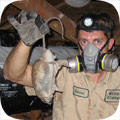 |
|
| I caught a fat rat today. A rotund rodent. A chubby chipmunk, a house of a mouse, a chair-splitter critter. I've never before caught a rat this fat. I checked the traps I set in the attic when I found this round mound. It all started on a Tuesday. On that day, I was
called out to a house in south Orlando. The dame who lived there said that she was hearing noises up in her attic. I didn't hear nothing, and I thought she was cukoo, but I decided I'd take a look up there anyway. Geeze Louise, she wasn't kidding. The attic was a regular rat toilet.
I saw rat turds up there that I never seen bef ...click for more |
03.12.2006 - Rat Poop Droppings & Waste in Attic
 |
|
| Here are two different photos of rat poop in an attic. On the left is a heavily-used rat pathway in an attic with blown-in fill insulation. On the right
is a section of scattered droppings in pink insulation. Both attics had a heavy rat infestation, and thousands of droppings scattered throughout. Rats have very
high metabolisms, and they poop a lot perhaps about 20 rat turds per day. Thus, they leave a lot of rat waste in the attics where they live. They also urinate, and the pheromone scent in the
urine and perhaps even the poo attracts new rats to the area. There is one ...click for more |
03.11.2006 - Critter Trapper Education
 |
|
| I was playing darts over Christmas with my new brother-in-law Sean, when he started asking me about my career as a nuisance wildlife removal specialist.
It told him that it was by far the best job I've ever had, and that I look forward to each day. Sean was doing a boring manager's job at the time, and when I described to
him the trapping in attics and wrassling with snakes, that's all he needed to hear, and he asked if he could sign on and train with me, so that he could start his own business
in his home town of Seattle. I told him sure, come on down to Sunny Florida and ...click for more |
03.10.2006 - Dead Animal Under a House
 |
|
| It was a dark and stormy night, except for the sunshine and gentle breeze. I fixed my steely eyes on the mysterious and foreboding abode
that lay before me, knowing what I had to do, but not quite ready to do it. Then I put on my blue suit and mask and head lamp, and I was in fact quite ready.
I found the secret portal to the labyrinth below the forbidden fortress, and said the secret password: "Open". The password didn't work, so I used my hands
instead of my larynx and removed the crawlspace door. I took a deep breath and started to crawl inside. But I had to let ...click for more |
03.10.2006 - Raccoon Active During the Day - Rabies?
 |
|
| One of the most common myths regarding wildlife is that a raccoon active during the daylight hours has rabies. That is just not true. I constantly receive phone calls from people who have spotted a raccoon active during the daytime, and they assume it
must be rabid, and they call me to report this information and perhaps request that I come and remove the dangerous animal. Raccoons are primarily nocturnal animals, but
the truth is that they do frequently forage during the daylight hours as well. In particular, raccoons that haven't found enough to eat, or females who ...click for more |
03.03.2006 - Squirrels in a Vent Pipe
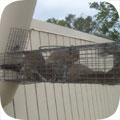 |
|
| This is an office building here in Orlando. The workers have been hearing a lot of noise up in their ceiling, all sorts of running about all day long.
Most of the time, noises during the daytime means squirrel activity. Other attic critters, such as rats or raccoons, are active at night. I came out to the building to
inspect, but I had trouble finding an opening for squirrels to get into the building. Everything was sealed tight, no open holes or chewmarks. The only thing I saw
amiss was a rip in a metal vent pipe. I thought that the pipe must be solid, with no opening into the ...click for more |
03.01.2006 - Snake Caught on a Glue Trap
 |
|
| What do I do when a customer calls about a snake in a home, but I am unable to find it upon my arrival? I set a glue board trap. This is the only effective trap that I know of for snake removal. I've
heard of funnel-type traps, and I suppose that they might work, but probably not as well as a glue trap. Before you set a glue trap for snakes, here are a few things to know: 1)YOU DON'T NEED TO KILL THE SNAKE. Once the
snake is caught on the glue trap, take it outside, and pour some vegetable oil on the snake - or spray PAM cooking oil, and the snake will wiggle itself free. ...click for more |
02.25.2006 - How to Catch an Armadillo by Hand
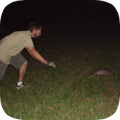 |
|
| When the armadillos get going, and I have no traps at my disposal, I have only one option - to chase them down with my bare hands, leap
upon them like a mighty lion, wrestle them to the ground, and then lose my grip on them and watch them flee into the forest. One might think that armadillos
are slow - what with the shell and all (snails, tortoises, clams) but no, they're quick little buggers. They scoot along in a series of quick, powerful hops.
I scoot along after them in a series of clumsy, awkward hops. Once I get near, the armadillo changes direction and ...click for more |
02.18.2006 - City Raccoon - Urban Raccoon Control
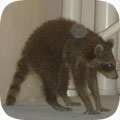 |
|
| Cities are chock-full of raccoons. It's this way not only down here in Florida, but all over the country. Raccoons have become urbanized city
dwellers. They used to stay only in the undeveloped forests. But raccoons are intelligent and adaptable animals, and they have learned that cities make a great
place to live. There's plenty of tasty garbage and pet food to eat, not to mention that handouts that some people insist on giving them (a dumb thing to do, and
ultimately unkind to animals). And there's also lots of great places to live that are far better than trees. From under ...click for more |
02.11.2006 - Rodents in the Attic
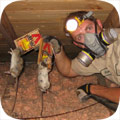 |
|
| Here I am, on a typical rodent in the attic job. This suburban house had a fairly large rodent infestation in the attic. The rats were climbing the walls of the house and chewing their way into a wooden eave, which had a relatively flimsy screen for a vent. It
was easy for the rats to detect the attic space, and to chew their way in. Rodents often seek out attics to live in for many reasons. The primary reason is for a warm, safe, dry, place in which to live. The rats can smell the air of the attic, they can detect the airflow
with their whiskers, and they know that there's a cavity in ...click for more |
02.06.2006 - Wild for Notre Dame! Irish Raccoons
 |
|
| Cheer cheer for old Notre Dame, Baby raccoons are relatively tame, Thus you can stick a hat on their head, And replace Charlie Weis as coach instead. What
thought the coons be great or small, Into your attic they always crawl, While your loyal wildlife trapper dresses them for victory. Yes, these little fellows are now
Notre Dame fans. I showed them the Notre Dame - Pittsburgh game, and raccoons are a natural enemy of panthers, so they decided to side with the Irish. One of them
scampered up my pant leg and stole my ND hat and put it on his head, while the other ra ...click for more |
02.03.2006 - Bat Removal in St. Petersburg
 |
|
| I recently completed this large and difficult bat removal project in St. Petersburg, Florida. This is a 4-story condominium, with a very tall roof, and a barrel tile mansard roof lining the perimeter. The
tiles featured, as many do, wide open gaps across the entire face of the mansard roof. Literally thousands of gaps, everywhere - at the top row of tiles, the bottom row, and around each and every tile. Bats need only
about 3/8 inch of space to get in and out, so this building required a tremendous amount of work, as is usually the case with barrel tile roofs. Though the sealing is ...click for more |
01.26.2006 - Project at SeaWorld Orlando
 |
|
| I took these photos of killer whales at SeaWorld in Orlando. This was during a bat removal project. A colony of Brazilian Free-Tail bats was living in the jumbotron structure overlooking the main display
tank at the Shamu Stadium. SeaWorld usually uses a specific company for their wildlife and bat removal needs, but this particular project was deemed too difficult for their regular bat removal company, so I was called in.
The job was unique for a number of reasons. First of all, the tower was surrounded by ....water. Ladders don't hold as steady on water as they ...click for more |
01.21.2006 - Photo of Bats in Flight
 |
|
| Do you like photos of bats in flight? Sure, we all do! They're hard to get, because bats fly at night, and cameras don't work as well at night. In fact, most people only get to see stray bats here and there, fluttering
about vaguely in the dark dusky sky - or flashing around a street lamp. It's not often that folk get to see a swarm of bats. Thus, it can be hard to get photos of bats on the wing. Unless of course one is sitting on the
roof of a condominium in which a thousand bats are going in and out. Then it's easy to photograph lots of bats. I like to look at the shots of the bats on the ...click for more |
01.20.2006 - Pigeon Control at Orlando Car Dealership
 |
|
| An Orlando area car dealership called me with a common urban problem: pigeons. The pigeons were roosting in several areas of the dealership, most notably on the raftors in the parking garage and on the concrete wall
above the showroom doors. The problem with pigeons is that they eat, which often means that they eventually poop. Pigeon poo is a problem. It's not just unsightly, it's caustic, and corrosive. This means that the pigeon
droppings that fell on the cars in the parking facility actually damaged the paint jobs of these new autos. A manager at the dealer ...click for more |
01.18.2006 - Raccoon Questions and Answers
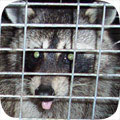 |
|
| I found your sight through a Google search and have a question... actually any advice you might be able to give. I'm located in the NW suburbs of Chicago & have had a raccoon mamma raccoon with her kits in my attic now, for aprox 18 days. She had the babies probably about
14 days ago ( that's aprox when I heard for the first time, the babies chattering). The raccoon entered my attic ( and is currently entering & exiting at night only ), from the front roof louvres... which she tore apart a wide enough opening. I've seen her numerous
times at night, come in and out of the ...click for more |
01.13.2006 - Poisonous Snakes Of Florida
 |
|
| There are six species of poisonous snake in Florida. Before I continue and describe them, I'll state that the correct term is actually venomous (a specific type of toxin that's actively injected) and not poisonous (any toxin absorbed via touching, eating, or
breathing), but of course I realize that many people aren't familiar with the difference, and are thus searching online for information on poisonous snakes. I'll also point out that poisonous snakes are relatively rare compared to non-poisonous ones. I think there's about 45
species of snake in Florida, and only 6 are pois ...click for more |
01.12.2006 - Squirrel Relocation
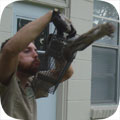 |
|
| Squirrels can be stubborn. Sometimes I try to release them, and they won't leave their cages. In fact, that's often the case for opossums and
armadillos as well. When I get a stubborn animal, I have a special trick. I blow on them! That's right, one good huff and puff, and out they go! Most
of the time, I relocate animals about 20 miles outside of the city to a wilderness preserve area. However, I was set to leave Orlando for a few days, and I had no other
animals to relocate, so I released this one in my back yard. Of course, this was over ten miles from the capture ...click for more |
01.10.2006 - Mouse Vs. Rat - How to Tell The Difference
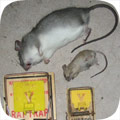 |
|
| Rats and mice are similar in appearance. In fact, people often confuse juvenile rats for mice, and the two do look extremely similar. While there are several species of rats and mice, I will examine the two most common ones, the Roof or Black Rat, and the House Mouse,
both seen in the above photograph. As you can see, the biggest difference is size. Rats grow to a body of 8 inches and a tail of 9 inches, and a weight of almost a pound. Mice rarely grow more than 3 inch body 3 inch tail, and a couple of ounces. Next is color,
and rats tend to be gray with white ...click for more |
01.03.2006 - Emergency Rat Shooting
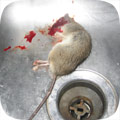 |
|
| I suspect David in the kitchen with the air rifle. I have learned, through ample experience, that the best way to get an "emergency" rat in the house is with the pellet gun. Here's how it works: Every now and then I get a call at 2:00 AM from a panting, stammering homeowner,
who informs me, between gasps for air, that there's a RAT in the house. The homeowner also informs me that I am to come and get it immediately. At this point I will either grumble and mumble something about the rat being
harmless, roll over and fall back asleep, or I'll grumble and get ...click for more |
01.02.2006 - A Dead Opossum in the Ceiling
 |
|
| Some dead animal removal jobs are very challenging - they involve persnickety housewives who recoil at the smell of day-old milk, and can
somehow sense a dead flea in the wall on the other end of the house. I arrive, can't smell anything above the scent of 50 sticks of incense and 30 lavender
candles, but persist on until I find the littlest critter tucked away in some impossible to find god-forsaken back corner of the house, barely raising the
slightest perceptible odor. Those are the lousy dead animal removal jobs. This one, this one was a pure pleasure. It was easy to ...click for more |
12.27.2005 - Pigeon Spike Installation
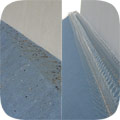 |
|
| This is a typical example of a pigeon spike installation project. I performed it at an office building. Pigeons were roosting on the ledges
above the main doors. They caused the usual pigeon problems - nesting material, feathers, and of course the main problem; lots of pigeon poo. The pigeon droppings
fell down onto the ground below, causing unisghtly and unsanitary conditions for the hundreds of people who entered the building daily. I inspected the problem
and determined that pigeons spikes were the best answer. The concept is fairly simple the birds are...click for more |
12.21.2005 - Fix Holes in Roof to Keep Out Animals
 |
|
| This house was located in a very fancy neighborhood in Orlando, right behind a gleaming white Mormon temple and surrounded by other beautiful houses. But
the inside of this house was not so beautiful and gleaming. It was filled with rats and squirrels, and all the droppings, urine, nesting material, parasites, and odor that come
with a rodent infestation. I was called in to take care of the situation. The homeowner heard a lot of scratching and running and scampering around, both day and
night. When I arrived at the home, I took one glance at it, and I ...click for more |
12.16.2005 - Possum in a cage in an attic
 |
|
| This was a somewhat typical possum in the attic job. I went to a home to inspect regarding some noises in the attic. When I got in the attic, it was easy
to tell that the culprit was an opossum. Possum droppings are very distinct. I inspected the roof and the soffits, and found a very large and easy entry point at
one of the eave gaps. I set some traps right at the hole on the roof, and sure enough, I'd caught two opossums the next morning. It's rare to get two, but I knew
that this meant that I was dealing with a winter denning group. In the winter here in FL, multiple ...click for more |
12.09.2005 - Dead Rodent in a Wall
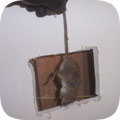 |
|
| I got a call about a smell in a wall in a hall at the mall. A rat did crawl, and then it did fall, and it curled in a ball, and it did not stall, if I recall, to offend all. With its smell, which smelled bad. I sniffed it out, then cut it out, then took it out, then looked about, and the people at the mall wondered what mistakes I had made in my life to be the guy who cuts dead rats out of the wall in the hall of the mall. But darn it all, I like my work, and if you don't like it, you're a jerk. I'm writing this way because I'm tired and my brain is nearly expired. When I can't write things of substance, I ten...click for more |
12.02.2005 - How To Find a Rat
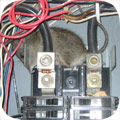 |
|
| It is my job to find rats. I am a rat control expert, specializing in the extermination and eradication of rats. I have to find both living and dead rats, and in the case of living rats, make them dead. In this case, a circuit breaker box did the job for me. This job
took place at a dental office. The dentist was finding rat droppings throughout the office, on the chairs, in the cabinets, and even on the dental picks and drill bits. These tools ended up in patient's mouths. Mmm!!! I was hired to solve the rat problem.
The first key to finding rats is to find out how they are ...click for more |
11.18.2005 - Snake in the Pool - How To Remove
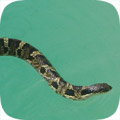 |
|
| I'm commonly called to Florida homes to remove snakes from swimming pools. Many snakes are aquatic, and are drawn to water. It's entirely possible
that they can sense water from a distance, as do many reptiles, perhaps by scent, or perhaps by seeing UV refraction reflecting off the water's surface. Regardless, a
body of water will attract certain critters, and snakes seem to commonly end up in people's pools. Of course, a swimming pool is not a suitable habitat in which to live.
The chlorine makes the water uninhabitable for most life, so there's no forage. I ...click for more |
11.17.2005 - Bat Exclusion Project
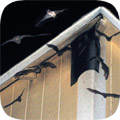 |
|
| Yet another normal bat exclusion project, though I did manage to capture this nifty photo. I don't always have a camera with me, and even when I do, I often get wrapped up in my work and forget to take
photos. Also, as is the rule, the best photo opportunities will always come when I have no camera. But this time I did, and I had a large swarm of bats swirling around me, trying to get back into a hole that I've
blocked off. Although there's only ...ten bats in this photo, it seemed as though a couple hundred were swirling around me. However, bats are very ...click for more |
11.16.2005 - Mouse in House - Get it Out
 |
|
| It's called a housemouse for a reason. Not because these mice are miniature construction workers who build quality residences. Not because they stay
at home while their spouse goes to the office. They are called housemice because they like to live in houses - PEOPLE HOUSES! Yes, that's right, mice are classified
as commensal rodents, who thrive off of the activity of people. If you like to live in a house, so does a mouse. Do you like the fact that your house is warm and
dry? So does the housemouse. Do you like the fact that your house is safe ...click for more |
11.15.2005 - Do Rats Chew on Electrical Wires in the Attic?
 |
|
| Many people ask me if rats chew on electrical wires in the attic. The answer is yes. Yes they do. I see it in almost every attic I enter for rat control jobs. Rats are rodents, and all rodent gnaw. Their teeth continually grow, so like a cat has to continually
scratch its claws, or just as you clip your fingernails, a rat gnaws in order to keep its teeth in check. They gnaw on a variety of surfaces, but they really seem to like electrical wires. This is a problem. They often expose current and thus heat to the wood beams in the attic, and
this is a legitimate fire hazard. It's estim ...click for more |
11.05.2005 - Dead Rat Removal Due to Poison
 |
|
| What have we here? A regular old smelly dead rat in the attic. Typical case, the homeowner called me with a terrible odor in the house,
and asked me to come out right away and find the source of this ungodly stench that no well educated middle/upper class American citizen should have to endure.
"Why has this horrible fate befallen me?" the lady of the house moaned and groaned. "My delicate nose shant tolerate such an injustice of nature. It is my right
to live in a fresh scented abode." Apparently it was also her right to spread rat poison in the ...click for more |
10.31.2005 - Florida Iguana Removal
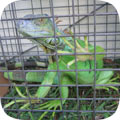 |
|
| I received a call about an iguana on the roof of a home. I consider this type of call an "immediate response" situation, because if I do not address the matter immediately, I likely won't have a chance to do so in the future. For example, many snake removals require immediate attention, before the snake slithers off and is lost. However, a case of squirrels living in the attic can wait a day, since the situation will not change day to day. In the case of this iguana, I knew that I would have to arrive quickly, or the iguana would climb down and run off. I am often unable to address the ...click for more |
10.25.2005 - Roadkilled Armadillo
 |
|
| "Why did the chicken cross the road? To show the armadillo that it could be done." Armadillos are amongst the most common of Florida's roadkill victims. Several factors contribute to this animal's tendency to
become vulture fare. First of all, armadillos are particularly vulnerable because they are not alert. Some animals are ever-cautious and aware, always keen of their surroundings, sniffing the air, feeling vibrations
in the ground, slinking off into the night before any chance of danger comes their way. Some animals bumble along through life, blindly ...click for more |
10.22.2005 - Orlando Florida Coral Snake
 |
|
| Behold! One of central Florida's four venomous species of snakes. This is an Eastern Coral Snake, perhaps 20 inches in length.
This snake doesn't really grow to a very large size, rarely much over 30 inches. I caught this snake in a customer's garage. Snakes often slither their way into garages, and
then get lost amongst the walls and debris. If you leave the snake alone, it will probably find its way out after a while, but I understand, in the case of the Coral Snake,
why one would not want it lurking about under dryer sheets. The venom of the Coral Snake is an ...click for more |
10.10.2005 - Duck Removal & Control
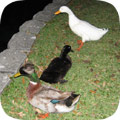 |
|
| I took this duck photo at Lake Eola. Ducks are welcome at Lake Eola, and no one that I know of is attempting duck removal there. However,
I have been called several times for duck removal. Most commonly, this is when ducks have taken up residence in a person's pool, and will not leave. I will
describe two scenarios in which I performed successful duck removal. The first was for a homeowner whose personal pool became the personal home to a mating pair of Mallard Ducks. The ducks would not leave the area. They had
not established a nest, but they chosen ...click for more |
10.09.2005 - Florida Diamondback Rattlesnake
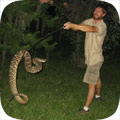 |
|
| This is the most awesome animal that I've ever caught in my career as a wildlife removal specialist. It's a 7 foot Eastern Diamondback Rattlesnake. This species of snake is the deadliest in North America, and this is one of the largest specimens. No documented
cases of an 8-footer have been verified, but that is probably the maximum length. Every now and then a 7-footer turns up, but it's rare that they reach 6 feet. This monster was huge and fat and
in perfect shape, with 12 rattles on its tail. I get many phone calls about rattlesnakes. 99% are false reports. ...click for more |
10.07.2005 - Animal In the House - Get it Out!
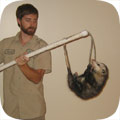 |
|
| It usually starts with a late-night phone call. I'm one of the few wildlife trappers who 1)carries his phone with him at all times 2)answers it 24/7/365 3)has no life outside of wildlife removal to distract me. Thus, when that call does come in at 2:00 AM,
I cheerfully answer it. This particular call came in at midnight. As usual, the caller didn't want to pay me to get out of bed, get dressed, and drive a half-hour away
to remove the critter. They never want to pay me. That's okay, I don't mind, it's all part of the job. I simply tell them that they can come to my house when I get ...click for more |
10.05.2005 - Bait Box To Trap Rat
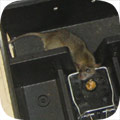 |
|
| While most rats tend to stay in the attic or wall voids, rats do often get inside the living space. Trapping rats in livable areas is a different matter than doing it in the attic. In the attic, I can set traps all over the place, with
no concern of a person or pet encountering them, nor worry about the sight of a trapped rat. But inside the home, there's human hands, feet, dogs, cats, and little children. I can't just leave a finger-breaking rat snap trap laying about in such a place!
Plus, many people don't ever want to actually see a rat. Thus, I have a solution for when there's rats ...click for more |
10.03.2005 - Dead Squirrel in Ceiling
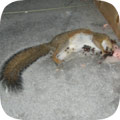 |
|
| A dead squirrel in a ceiling is no big deal, really. It happens all the time. Squirrels live in ceilings, homeowners are too lazy or cheap or ignorant to have them removed when the squirrel is alive, but then eventually it dies and creates a horrible smell inside the home, and then the people therein decide to do something. To be fair, some people don't know that they have squirrels up in the ceiling, but these same people must also be deaf. Anyway, they do have a sense of smell - they are not asnomiacs - and then I get called to do the dirty work at my low, low pri...click for more |
10.02.2005 - Wildlife Career - Removing Problem Animals
 |
|
| I am very happy to have a career as a nuisance wildlife removal specialist. Many people ask me for jobs. Perhaps 100 or so people per year, in fact, find my website and request employment. I operate alone, so I must tell all of them that
I'm not hiring. To be honest, the majority of the requests are from guys that sound like uneducated rednecks, and they cite their wildlife experience as their love of snakes. That's about a third of the requests. Some of the others are just guys that are looking
for a job, any job. Then another large chunk of job requests are from people that ...click for more |
10.01.2005 - Raccoon Trapping Tips
 |
|
| The below tips are meant for live-trapping raccoons. I have never used lethal traps for raccoons, nor have I ever killed a raccoon (other than a few cases
of sick animals that needed to be humanely put down). So this page is not meant for fur trappers who use lethal traps or paw-hold traps. Tip #1 - Use a Large, Sturdy Trap - The right type of trap is important. I've used several types and brands, and some have failed - raccoons have escaped due to design flaws. There's several good brands out there, such as those by Havahart and Tomahawk and others, but
just know ...click for more |
09.22.2005 - Fastest Snake in America
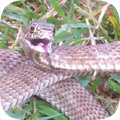 |
|
| This is the fastest snake in the United States of America, the Eastern Coachwhip. It has a top land speed of about 10 m.p.h. and a top air speed of 190 m.p.h. like most aerodynamic objects reaching terminal velocity. Ten miles per
hour may not seem fast, but it is. It's a fast snake! I've seen only two in my life. I caught the above snake, and it took all of my speed and cunning. The second Coachwhip
that I saw was too fast for me to nab, and it escaped under a mobile home. This snake is fairly rare, but another more common snake, the Black Racer, is almost as fast.
...click for more |
09.20.2005 - Baby Squirrel with Peanut
 |
|
| Squirrels are cute for about three days. Seriously. That's how quickly they grow up. They are born ugly, hairless, sealed-eyes little things.
Not pleasant to look at. Then they start to sprout fur and such, and they still look like pitiful little hair transplant victim rats. Then you blink your eyes, and
they look like adult squirrels. They really grow quickly. In the process, there is about a three-day span during which they look like the above photo. Awww....
cute!!!! Super cute!!! I happened to remove a few squirrels in this cute stage today. They were in an attic of a home, in ...click for more |
09.15.2005 - Racoons in Attic
 |
|
| This is probably the third most common job that I do in my profession as a nuisance wildlife removal specialist - the racoon in the attic. The most common
job is rats in the attic, followed by squirrels in the attic. But raccoons are also very common. A typical job, such as this one, goes as such - I get a phone call
from a homeowner who has been hearing a big racket in his/her attic, mostly at night. The noise is usually described as very loud or heavy, and often accompanied by vocal
noises, such as squealing or chattering. Sometimes the homeowner knows it's an ...click for more |
09.01.2005 - How to Solve an Armadillo Problem
 |
|
| How to Solve an Armadillo Problem? Well, first of all, identify the exact problem. Is the animal digging up the yard? The flower beds? Has
it made a large burrow next to the house? Is it living under the porch? Is it driving your dogs wild at night? Now that you've got the problem identified, you
can pursue an exact armadillo control strategy tailored to the individual needs and nuances of the circumstance. So for example, if the problem is digging in
the yard or flower bed, I recommend trapping and removal to solve your armadillo problem. If it's burrowed next to the house, the ...click for more |
09.01.2005 - Crab Removal
 |
|
| I was working on a bat removal project in Hobe Sound Florida, when something caught the corner of my eye. It was an odd shape and color, and it was moving unlike anything I'd ever seen before. "What in the hell is that?" I thought. I walked over
for a closer look, and was amazed to see this crab. I do not know the species, but I believe it might be some sort of fiddler crab. The fact is that I had no idea that I was close to any body of salt water. In fact, I was still over a mile from the ocean. In addition,
this house was surrounded by a large stone wall, so I didn't ...click for more |
08.25.2005 - Snake Hook
 |
|
| Here I am seen holding a snake on a snake hook. The snake hook is a very handy herpetologist's tool. It's used for the safe and easy capture and transportation of snakes. It is most useful when it comes to venomous snakes, which one would not want to
risk handling by hand. The hook can be used in a variety of ways, but the most common is to simply scoop the snake up under its belly and lift it. The snake is draped over the hook, and it then has no leverage with the ground, and no space for peristalsis movement, and so its
pretty much just stuck hanging there. ...click for more |
08.18.2005 - Bats in the House
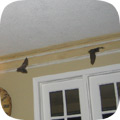 |
|
| Few events in my field seem to cause as much gut-fear as live bats flying around in the house. Only snakes and rats seem to do a better job of eliciting shrieks, fainting, and pant-soiling from unwary
homeowners. Well first of all, calm down. The bats will not attack. These bats in the home don't want to be there any more than you want them there. Whereas rats often enter the home on purpose - because people
tend to store food in the pantry, bats enter homes by mistake. Most people wonder how the bats got in. "Did I leave a window open?" they think. "No you didn't", I ...click for more |
8.13.2005 - Dead Critter Under the Bathtub
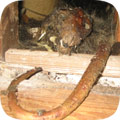 |
|
| I know some folks consider it morbid, the way I photograph and write about dead animal carcass removal. But it's something that I do, and I do it very well, and when people need my services, they NEED my services. I was very proud of this dead animal removal, and I don't become proud over much. I'm not all that proud of my college degree or my boxing or swimming trophies or any of that, but man, this dead animal removal kicked ass. First of all, the homeowner had already called out THREE different companies before me. All the big names around here...click for more |
08.01.2005 - Animal on the Roof - Opossum
 |
|
| Most of my customers call me to complain about the noises that they hear an animal making. Most of the time, these noises are from animals living inside the attic or walls of a house. However, from time to time people hear animals scratching and clawing on the
roof. I do many jobs in which I simply trap and remove animals that have a habit of spending time on the roof and making noise night after night. Some of the time these are animals that have incorporate a roof into their normal nighttime routine rout, but most of the time, the
critter is on the roof because it is ...click for more |
07.28.2005 - How to Kill Rats in the Attic
 |
|
| If you have rats in the attic, you want to solve the problem! Rats chew on wires, make a lot of noise running around and scratching, and can spread disease. Once they've infested a home, the problem doesn't go away until properly solved. You do want to kill the
rats in the attic to solve the problem, but that's only a part of an overall solution. There are many ways to solve a rat problem, but over the years and with many different experiments, I've determined the best way to solve the problem permanently. You don't want to simply
kill the rats. That will not solve ...click for more |
07.23.2005 - Photograph of Striking Snake
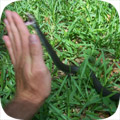 |
|
| Oh no! I'm about to face the paralyzing strike of the deadly Black Mamba! I have only a few precious minutes of life left to
make this web page about the bite and to change into some nice clothes for the morgue! Never mind updating my will, calling loved ones, and reflecting on life - I have a duty
to provide my readers* with the above photograph and account of the incident. Hmm, I seem to still be alive... I suppose that perhaps this wasn't a Black Mamba after all, but
a harmless Black Racer. Yes, now that I look at the picture carefully, I see that this is ...click for more |
07.18.2005 - Barrel Tile Roof - Allows Rodents In Attic
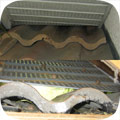 |
|
| Here is a photo demonstration of one of the classic problems with barrel tile roofs, and the reason homes with such roofs have such a high rate of wildlife
problems. Barrel tile roofs lead wide-open holes into the attic! I have taken two photos of the same area - one as seen from outside, and one of the same area,
taken from inside the attic. You can see that this house has a barrel tile roof - these curvy Spanish-style tiles are very popular in Florida. And of course the
house has soffits, the bottom of which are flat. With a flat roof, the soffit lies flat. With a barrel tile roof ...click for more |
07.15.2005 - Wounded Armadillo
 |
|
| I caught this armadillo, and it had a large wound on its back. The injury looked fairly fresh. I do not know what caused this. Armadillos
don't really have any significant predators in the United States. I doubt that this was the work of another animal, such as a coyote or dog. Most likely, this
was the result of a collision with a car. Why then, the big cut on the back instead of flattening tiremarks? Because armadillos tend to jump when startled, so
perhaps a car passed over the armadillo and it jumped up into the undercarriage of the car and got this injury. Or perhaps it was ...click for more |
07.09.2005 - Florida Softshell Turtle
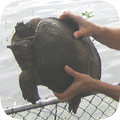 |
|
| Today I saved this Florida Softshell Turtle (Apalone ferox). I was enjoying a peaceful Sunday afternoon, my first time off in 74 days. Suddenly, I heard a knock at my front door. A concerned citizen had found a trapped soft shell turtle! He saw
that I had a truck marked "wildlife removal" in my driveway, and he thought that perhaps I could help. "Of course I'll help!" I said, putting down my lemonade and setting aside my book. I followed him out to a nearby lake in downtown Orlando. Sure enough, there, in a
fenced-in section next to the lake, sat a Florida Soft Shell Turtle. ...click for more |
07.09.2005 - Mexican Free Tailed Bat
 |
|
| In this particular photo, we see a bat that I caught at a customer's home. One would normally never see me handling a bat in this manner. First of all, my bat exclusions are done with a minimum of stress put
upon the animal. The bats are never physically touched - they are removed in a safe and gentle way. Secondly, bats are very fragile. The wings are actually analagous to hands, with a thin membrane stretched across the
finger bones. As with any flying animal, the bones are thin and light, and anyone who handles a bat without the gentle touch of a dentist could break ...click for more |
07.02.2005 - Florida Lizards
 |
|
| When I was a small child, I loved to collect reptiles and amphibians. The sight of a mere toad filled me with a sort of brilliant and breathless thrill that winning the lottery today would not nearly match. It'd be hard to describe
just how much, at my tender young age, I longed to catch and possess the creepy crawly critters of the world, particularly if they were covered in scales. So at the age of four years old, my family took a vacation to Disney World Resorts in Orlando. During
that trip, I made all sorts of innocent four-year-old discoveries, such as the day I dug a deep ...click for more |
06.30.2005 - Mess Under House
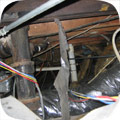 |
|
| My job as a wildlife removal specialist requires that I go where the animals go - in order to trap them, to find out how they are entering a house and repair
those holes, and to remove dead animals where they lie. Oftentimes, I work underneath homes. Here in Florida, many buildings are elevated due to the high water
table and the chance for flooding and water damage. Thus, many buildings have crawl spaces underneath, and these areas are very attractive to wandering critters in search
of a home. I often set traps underneath homes. I often perform repairs on ...click for more |
06.21.2005 - Yellow Rat Snake
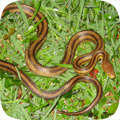 |
|
| This is a photo of a Yellow Rat Snake, Elaphe obsoleta quadrivittata. This is one of the top eight most common snakes
that I catch in the state of Florida. This snake ranges across the southeast, and the whole state of FL. It's one of the larger snakes in the state, and can reach a length of 6
feet, although it is quite thin. It's got a mustard-yellow body, sometimes dark yellow or tan, with four dark brown stripes along the length of the body. It mates in May, lays
eggs in June, which hatch in August. The baby snakes look nothing like the adults - they are black ...click for more |
06.20.2005 - Do Plastic Owls Keep Away Pigeons?
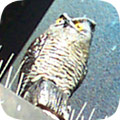 |
|
| One of the great jokes of the nuisance wildlife control industry is the use of fake plastic owls for pigeon
control. The theory is simple enough. We know that pigeons are terrified of one of their natural predators: owls. Thus, why not use owl decoys to scare
away pigeons? Unfortunately, it doesn't work in practice. It might be the equivalent of some nuisance human control operator setting up a fake plastic
boogie man (or IRS auditor, mother-in-law, insert scary human here) by your front door in hopes that it'll keep you from entering your own home. It just
won't work...click for more |
06.18.2005 - How to Solve Raccoon Problems
 |
|
| Crikey! Florida attics get hot! It's now late June, and the temperatures outside are in the mid-nineties. But the temperatures inside attics
are in the mid 140's. Some of these attics are like ovens! The air is so hot, it's hard to breathe! I don't know how raccoons can stand to live in an
environment like this, but they do. I went to this home today because of scratching in the attic, and I came out completely drenched with sweat and with these two little
critters! Usually a mother raccoon has four young per litter here in Florida, but there were only two of these 10-week-olds. I ...click for more |
06.16.2005 - Attic Decontamination - Clean and Deodorize the Attic
 |
|
| This is a standard attic decontamination job. This attic was infested with rodents - both Roof Rats and Eastern Gray Squirrels. I trapped and removed all of the animals and indentified and permanently sealed shut all of the entry points. However, the attic remained vulnerable, because the rodents had left behind their scent, and the entire border of the house was vulnerable. The rats and squirrels had chewed their way into the wooden fascia board and right down into gaps in the wooden roof that lay below barrel tiles. It's important to remember that rodents communicate via t...click for more |
06.12.2005 - Dead Rat on Glueboard - Do Glue Boards Catch Rodents?
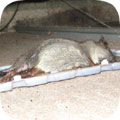 |
|
| I arrived at a school in order to investigate a bad smell in one of the classrooms. The school had abandoned use of the room for a couple of days due to the odor, and finally decided to call me out to find and remove the source of the smell. Most dead animal jobs take me either five minutes or two hours. That is, the animal is either dead in some obvious and easy to access location, or it has died in some impossible to find and impossible to reach area. This was a five-minute job. I opened the drop ceiling panels, and voila, I found a dead rat stuck to a glue bo...click for more |
06.06.2005 - Dead Squirrel in the Attic
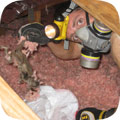 |
|
| I got this dead squirrel out of the attic. It was a girl, and it died out of attack. Someone or something had attacked it with poison. It sniffed it and ate it and that was the roison. Reason a female squirrel died - due to the anticoagulant in the rat poison. Squirrels rarely eat rat poison, so I was surprised. They usually don't eat anything up in the attic, and will normally only eat outside. However, this one managed to eat some poison, at least my autopsy (brief glance and nonchalant assumption) results say that it did. I guess that it could have died of natural causes as well. ...click for more |
05.25.2005 - Extraction of a Snake from an Attic
 |
|
| Snakes in the attic, snakes in the attic, all I keep hearing about is snakes in the attic. Some people are afraid of snakes, and when they hears noises, or even
nothing at all, they sometimes worry that it's a snake, or a whole mess of 'em, slithering around doing their dirty snake business up in the attic, no doubt plotting a
way down into the home to suck dry the innards of the sleeping innocent within. Most of the time, these paranoid folk are wrong. But not always. Sometimes they are right.
Not about the sucking of innards, but about the snakes in the attic. For you see, ...click for more |
05.20.2005 - Does Bat Repellent Work?
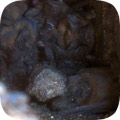 |
|
| Many people seek an inexpensive and easy cure for their problems. Why not? If a pill can cure obesity, it sure beats diet, exercise, and liposuction, right? Magic diet pills sell fairly well. So does wildlife
repellent, bat repellent included. Sellers of both "guarantee" that their product will work, and offer countless testimonials. Or your money back! It's not unusual for me to arrive at a bat problem only to find that the homeowner has already attempted use of a magic bat removal product, oftentimes several. Shockingly, the very
people who are gullible enough to buy ...click for more |
05.18.2005 - Armadillo Trapper in Orlando FL
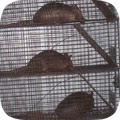 |
|
| Here is a photo of four adult armadillos, all caught in one day. This is the peak of the armadillo trapping season. Well, there is no real
season to speak of, since armadillos are active year-round and the population is relatively stable, but for some reason, I get more armadillos at this time
of year. These dillos all came from different properties. It's rare to catch more than one armadillo at any given time on a single property. Over a course of
days, yes, as different armadillos with overlapping territories cross the area, but in general, dillos are solitary creatures, ...click for more |
05.15.2005 - Possum Mother with Babies
 |
|
| This is one of the better nature photos that I've taken. A customer called me, concerned about an opossum on their property. They said that the
opossum has been living under their shed for several months now, and it's driving their dog crazy. The homeowner said that she has been reluctant to let her dog out when
it's around, for fear that her dog will harm the mother opossum or the babies, or that the mother will attack the dog out of self-defense and to protect its young. Thus,
when she did let her dog out and the opossum went up in a tree and she felt that it cou ...click for more |
05.12.2005 - Dead Catfish Under a House
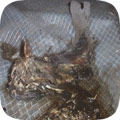 |
|
| I got a standard call for a bad smell in a house. When I arrived, I knew that I was dealing with a dead animal, but the smell was slightly different than the usual rats, opossums, squirrels, and such that I deal with. Still, odors do vary depending on several factors, such as state of decay, temperature, ambient odors, and so on. I searched and searched, and could not find the source. I went under the home as usual, and finally I found the dead animal. It was not, as I usually find under a house, an opossum or cat. Well, actually it was a cat - a cat fish. This is the fir...click for more |
05.08.2005 - Raccoons in Chimney - Get them Out
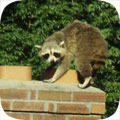 |
|
| Your chimney is just like a big, hollow tree to some animals. Critters such as squirrels and raccoons are great climbers. They need a safe,
dry place in which to live, so if your chimney has no chimney cap, get ready for some visitors! Female raccoons instinctively seek out high areas in which to create a
nest. Because raccoons are so common in urban areas, they often climb on houses and other buildings looking for a good place to set up a nest. If they see an open
chimney, that's a great place to pick. They can easily climb down the flue, as ...click for more |
05.07.2005 - Florida Redbelly Turtle
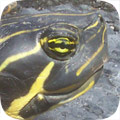 |
|
| I am unsure of the exact species of turtle here. I believe that it is a Florida Redbelly Turtle. It might be a type of Cooter turtle. I found it while working on a bat project in Saint Petersburg. I was working on a building when I
found it walking along the parking lot. The entire area was fenced in. I'm not sure if the animal was stuck or migrating to a new area. I often wonder how slow animals like this can migrate to new areas, but I suppose that slow and steady wins the race.
I didn't see any good habitat areas on the condo property, but the turtle must have come ...click for more |
04.30.2005 - Infant Rats - Roof Rat Babies
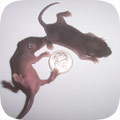 |
|
| I got these infant rats today. I'm working on a rat control job in Longwood, and I've got the whole home sealed. I've trapped two rats, but the customer said that she still heard noises coming from the bottom of one of the walls. I went to her
home to inspect, and sure enough, I heard the very faint scratching coming from the bottom of the wall as well. I went up into the attic, but there was no way I could see down that wall void from the attic space. So I got my trusty drywall saw and cut a hole in the
wall just above the scratching noise. There, at the bottom of the wall void ...click for more |
04.21.2005 - Mystery Animal In a Tree
 |
|
| I have a very strange customer. Her name is Hilda. She calls me all the time. She won't leave me alone. She has problems. She hears things. She sees things. Then it becomes my problem, because I hear my phone and I see that it's her number calling me
yet again so that she can talk my ear off about her latest wildlife problems. "David, David! This is Hilda! I am hearing them again, they are keeping me awake, they are making so much noise, David, you must come help me David!". Except that her voice
is much more annoying than the voice you used in your own ...click for more |
04.18.2005 - A Bat Flying in the Attic
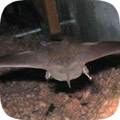 |
|
| Here we have a photo of a bat flying in an attic. As you can see, the bat is flying away from me. It's not as exciting as a shot of a bat flying toward me, but as with most wildlife, this one would rather
get away from the large sweaty hairless biped than approach it (note to ladies - I'm not always sweaty, but when in a Florida attic, it's unavoidable). This photo is actually quite rare, at least in Florida, for three
reasons. First, it's usually hard to ever capture a photo of a bat on the wing, because they move so dang fast and erratically. Second, if I can capture a shot of a ...click for more |
04.12.2005 - Squirrel Hole Fix
 |
|
| Here I am, doing my job as a nuisance wildlife control operator, up on a stepladder, bolting in a new vent cover to keep wildlife out. It's about more
than just catching critters. In my opinion, the more important step is in preventing them from causing problems in the first place. This home had squirrels in the
attic. They were able to enter the house via these vent holes in the soffit. The flimsy vent covers have rotted and fallen out over the years, and it's a very
simple access point for squirrels and other animals. Squirrels can climb concrete walls like this, or just go ...click for more |
04.09.2005 - Water Moccasin
 |
|
| This is a photo of a Florida Water Moccasin. It's more commonly called a Cottonmouth, but Water Moccasin is the second most popular name. This snake apparently also goes by black moccasin, blunt-tail moccasin, congo,
cotton-mouthed snake, gapper, highland moccasin, lowland moccasin, mangrove rattler, North American water viper, pilot, rusty moccasin, saltwater rattler, stub-tail, stump moccasin, stump-tail moccasin, swamp lion, trap jaw, Matt Cassan's moccasin, true horn snake,
water pilot, obstucted bowel serpent, water rattlesnake ...click for more |
04.04.2005 - Fox Removal
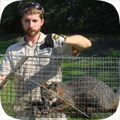 |
|
| Every now and then I catch a fox. Such as today. Today I caught a fox. I never intend to catch a fox. They simply wander into my trap. I usually bait with non-meat items, so as not to attract cats. My target species for this size of a trap,
usually raccoons, opossums, or armadillos, do not need meaty bait. Yet foxes are lured into the traps regardless. I don't know if they're simply scavenging up the marshmallow (or whatever I've used) bait, or if they can smell the scent of a previously caught opossum,
but I've caught several foxes. I like foxes. They're shy ...click for more |
04.03.2005 - Dead Bear? No! Dead Cow!
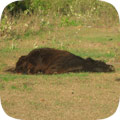 |
|
| How now, brown cow? Dead, that's how. I received several phone calls about a dead bear just off Rt. 417 near the Conway exit. One
person said that it was a 12-foot dead bear. These calls piqued my curiosity, so I resolved to see the giant dead bear. During my normal day of nuisance
wildlife control work, as I traveled along Rt. 417, I remembered to stop and take a look. I saw several cars pulled off to the side of the road on the
northbound side (where the dead bear was), and traffic slowing on the other side of 417 as well. I became very excited with a rapid heartbeat...click for more |
03.27.2005 - Rat Extermination
 |
|
| Many of my customer seek out rat extermination. I think it's very important that people understand that there are many different methods of rat control,
and that extermination can be done correctly, or very poorly. Most companies that are classified as exterminators deal with insects, and they exclusively use poison.
These companies deal with rats in the same way, with poison. The use of poison is a terrible approach to rat control. It's by far most inhumane, least effective,
and most likely to cause negative externalities of any approach. First, as to ...click for more |
03.16.2005 - How To Kill Raccoons
 |
|
| This is a larger-than-average raccoon for the state of Florida. Most of the raccoons down here tend to the small size, with adults averaging about 9-10
pounds. This one was 16 pounds. Not huge, but a good size for this area. It was doing a common raccoon faux-pas: pooping in a swimming pool. Raccoons
love water, and they like to splash around, and wash their food (their name means "washes with hands") and they also like to poop in water, just like people! The reason
is to hide the feces, I suppose. So they go on the shallow step and poop there. The home ...click for more |
03.14.2005 - Pigeon Trapping in Cage Traps
 |
|
| The majority of the time, pigeon control centers around abatement practices - the installation of physical deterrents that prevent them
from roosting in undesirable areas. An example is the installation of pigeon spikes on a store sign in order to prevent them from landing on the sign. However,
at times pigeon trapping and removal is a desirable solution. For example the building may be too large in order for spike removal to be cost effective. Or
perhaps the pigeons are roosting on or in an area where spikes or other deterrents won't fit or can't be installed. ...click for more |
03.12.2005 - Raccoon Poop - Droppings & Waste in an Attic
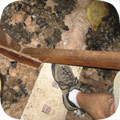 |
|
| Holey mackerel, this attic was a mess! I don't know if you can see very well in this photo, but the whole place was filled with huge piles of raccoon
poop. The insulation used to be pink, but now it's mostly brown from mud and urine stains, and the buildup of raccoon poo is tremendous. This is just one section of
the attic, but the whole attic was filled with raccoon waste. It smelled terrible. This home was in the Pine Hills, in a run down house, and I think the raccoons must have been using this attic for
years. The raccoons had access to many wide-open entry points. This job ...click for more |
03.08.2005 - How To Stop Squirrels from Chewing
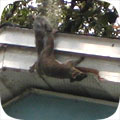 |
|
| Squirrels are members of the rodent family. As such, they have long teeth that grow continually. Just as a cat has to scratch its claws and people
have to trim their fingernails, rodents have to gnaw to keep their teeth in check. Gnawing is part of their behavior, and handy for all sorts of things, from opening nuts
to yes, chewing their way into your house. I commonly deal with situations in which squirrels chew their way into homes. I have dozens of such photos (I always
photograph animal damage to show my customers what needs fixing), but this is the first ...click for more |
03.03.2005 - Bat Control Project
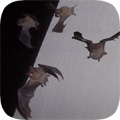 |
|
| I took this photo working on an apartment complex that harbored a very large colony of Brazilian Free-Tailed Bats. The bats entered the apartments via very large gables, which had exposed fascia gaps. These
gables were about 60' long, and three stories high. The bats were able to enter throughout the length of the gable, but most chose to enter and exit near the ends, where they had the most clearance. I used six exclusion
nets on every gable. Most of the bats used the ends, where I took this shot from atop my ladder. Oftentimes when I'm working in a public setting ...click for more |
03.03.2005 - Closeup Photograph of an Armadillo
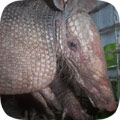 |
|
| I am very pleased with this closeup photo of a handsome armadillo. Truly one of nature's lovliest creatures. Some like the colorful feathers
of the peacock, or the happy smile of a bottlenose dolphin, or the cute fluffiness of a kitten, but no one can deny the rugged good looks of the Nine Banded
Armadillo. Just look at that bright and inquisitive eye, or that smooth skin. How about that cute little beard, or those adorable feet? Some animals were
built for rugged utility, and some were built for pure cuteness, and I have to say that the armadillo rates at least nine ...click for more |
02.20.2005 - Common Snakes of Orange County, Florida
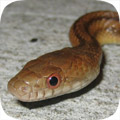 |
|
| I'm frequently asked about the common snakes of Orange County. The above photo is just one of the common snake species in
Central FL. It's a Yellow Rat Snake. I actually found it on the sidewalk in a heavily developed strip mall area here in Orlando. It's one of the snakes that seems to thrive
fairly well in developed areas. Because Orange County is so heavily developed, it's these sort of snakes that are more common. I will now list, in order, the six most common
snakes that I remove and see here in the greater Orlando area, and my estimate regarding the ...click for more |
02.18.2005 - Sandhill Crane Removal
 |
|
| Sandhill Cranes, Grus canadensis are fairly common in Florida. They are a very large bird, with a wingspan of about six feet. I've
read that they are the oldest known extant bird species, with unchanged fossils going back 10 million years. As a dominant bird species, they are usually
fearless of other birds and most other animals, including humans. They became a nuisance in this parking lot of this company, where they routinely threatened
the employees and customers with agressive behavior. I was called in for Sandhill Crane control. I am not ...click for more |
02.13.2005 - Tug-O-War With a Possum in the Attic
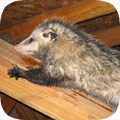 |
|
| This customer was hearing noises in his attic every night. He figured that it was a wild animal, and thus called me. I asked the usual questions
about the noises - time of day, volume, amount of scratching, amount of running, etc. From his answers, I suspected an opossum. Rats tend to scurry very fast
through the attic and walls, and scratch. Same for squirrels, minus the walls, but squirrels are active during the daytime, rather than the night. Heavier, slower
noises at night most likely means raccoon or opossum, and the lack of vocal noises indicated opossum ...click for more |
02.11.2005 - Rat in the Toilet - Removal
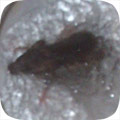 |
|
| Do rats come into your house through the toilet? Yes, I've seen it happen. However, it's very rare. To do so, the rat has to go through the plumbing pipes and through a waterlogged area, and that's just plain unlikely. Rats don't go somewhere unsafe unless they
know there's a way out on the other end. So the truth is that the cases I've seen in which rats enter a home via a toilet are via toilets with the water shut off! Also, the rats here in Florida are Roof Rats, and they tend to stick to the high trees and power lines and rooftops, and not
down in the sewers. Up north ...click for more |
01.29.2005 - Infant Squirrels
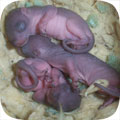 |
|
| This was a very interesting job. A squirrel was entering and creating a mess in an antique store. It was running all through the shelves, knocking
things over, and it broke several expensive glass pieces. The store owner was very upset! He called me to trap and remove this squirrel. I came to the store
and the building had all sorts of flaws. It was easy for animals to get in by many places, such as a wide gap around the perimeter of the ceiling. It would be
impossible to seal off all the squirrel entry points without major renovations. The owner simply wanted the ...click for more |
01.24.2005 - Raccoon Nest in Attic
 |
|
| Here's one of the finest sights a nuisance wildlife removal expert such as myself can see. It's a nest of baby raccoons. I frequently go to homes to
solve problems with wild animals living in attics. I'm not always sure of what the culprit will be. It's usually rats, squirrels, opossums, or raccoons. I can
usually make a good guess based upon the description of the noises the customer is hearing, but not always. Some people think that rats sound like packs of big dogs
running about! Regardless, when I get in the attic, I can read the signs (i.e. the tracks and the poop) ...click for more |
01.08.2005 - Animal Poop in the Attic - Diseases from Wildlife Waste
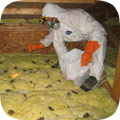 |
|
| If you've had wild critters living in your attic, it's a good idea to have the attic cleaned. Wild animals leave their waste behind when they inhabit an attic. This waste can carry a number of zoonotic diseases. There are at least 42 important diseases that people get by ingesting or handling food or water contaminated with animal feces, such as Campylobacter infection, which us found in animal feces, and causes gastrointestinal symptoms. There's also Leptospira infection. Humans get infected via contact of insulation containing urine from infected animals. Left unt...click for more |
12.23.2004 - Snake Catcher - How to Catch a Snake
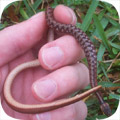 |
|
| Many people ask me how to catch a snake. Before I explain how, I want to stress that oftentimes, it's best to leave snakes alone. Second, it's very important that you are able to identify snakes, and know which ones are dangerous,
and which ones are good and beneficial to have around. Okay then, your four major options for catching a snake are: 1)By hand 2)With snake tongs 3)With snake hook 4)With snake trap. I will analyze these four methods now.
1) By Hand - I've caught the snake in the above photo by hand. I catch most of my snakes by hand. This is because ...click for more |
12.22.2004 - Rodent Extermination
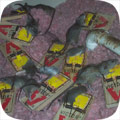 |
|
| Rodent extermination, From my rat association, I set a trapping station, Of my own creation, When to my elation, I found that my location,
Built a large foundation, Of dead rat decoration, It was a revelation, When my trapping preparation, Made the operation, A thing of admiration, It was my
expectation, Based on a conversation, That I lacked the education, To cause rodent anniahlation, And I hit the realization, That the situation, Could be solved by
motivation, And trap administration, Rats are my occupation, I run a rodent corporation, I cause pulverization, Of ...click for more |
12.07.2004 - Raccoons on the Roof
 |
|
| Raccoons are excellent climbers. They are very strong, they have very nimble hands, and they can actually swivel their hind feet 180 degrees, allowing
them excellent grip and the rare ability to descend a tree (or a wall, downspout, or screened-in pool such as seen above) headfirst. Thus, raccoons commonly crawl on the
roofs of homes. Raccoons go on roofs for many reasons. They often crawl up there for a safe place to spend the night. Some people call me simply to report
sleeping raccoons on top of houses. Other times, they may crawl just for the heck of it. I've wo ...click for more |
12.06.2004 - Eastern Coachwhip Snake
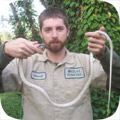 |
|
| Sweet! My first Eastern Coachwhip! I've been reading about this snake, and always wanted to catch, or even see, one. Today I finally got my chance. A customer called about a snake terrorizing his lawn, and now hiding under
a large piece of plywood. I arrived at the house, and upon lifting said plywood, out shot this snake like a lightning bolt! The Coachwhip is the fastest snake in North America!
But it's not faster than me. I pounced with my super duper lightning mongoose speed, and captured the hapless serpent. It struck a few times, but I was impervious to the
...click for more |
11.24.2004 - Dead Pigeons in Ceiling
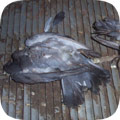 |
|
| I found these dead pigeons in the ductwork of a public building. They had an open mushroom vent on the roof, and a large colony of pigeons
was entering the ducts and living there. They made a huge mess in the ducts, complete with nests, eggs, a ton of droppings, and quite a few dead birds. Pigeons
are often filthy animals, and they simply do not keep clean quarters. They don't live long in cities, and like any other wild animal, carry some risk of disease.
They are known, in particular, to be susceptible to salmonellosis, tuberculosis, and ornithosis, but we know ...click for more |
11.19.2004 - Squirrel Poop - Droppings & Waste in an Attic
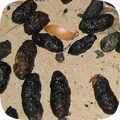 |
|
| Here is a close-up photo of squirrel poop. I took it from an un-insulated section of attic space, or essentially, above a ceiling in a house that was
filled with squirrels. The squirrels left thousands of droppings sprinkled throughout the attic, but this was just one tiny area. Most of the squirrel turds in this
area are pretty fresh. Though some are old, you can see that they are drier or have mold growing on them. It's often hard to distinguish between squirrel and rat droppings. Squirrel
droppings are just slightly larger, and slightly shorter with more rounded ends. But it's not ...click for more |
11.18.2004 - Do Mothballs Repel Armadillos?
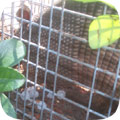 |
|
| I am annoyed at mothballs. Somehow, somewhere, someone got the idea that mothballs would repel wildlife. Now I encounter mothballs on a
weekly basis - inside homes occupied by animals who don't give a crap about mothballs. Armadillos are just one such animal for which people use the magic
cure-all critter repellent, mothballs. Thus, this homeowner dumped a box of moth balls down this armadillo hole. Amazingly, the armadillo didn't care. As
you can see in the above photo, lower right side, the armadillo continued to use the burrow, and some of the ...click for more |
11.17.2004 - Frog Removal, Control, Get Rid of Frogs
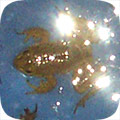 |
|
| This was certainly one of my more unusual jobs. A lady called me, stating that her swimming pool was full of frogs, and she asked me if I could remove them. Although this was uncharted territory for me, the fact is that many of my jobs are
actually uncharted territory, and this didn't sound terribly difficult. I figured that I'd show up, and by hook or by crook, I'd catch those frogs and save the day. So we scheduled a time and I showed up, but I soon realized that I needed neither hook nor crook,
but rather a net. I had some nets, but the size of the pool made the skimmer a fair ...click for more |
11.09.2004 - Roof Rat - Control, Removal, Trapping
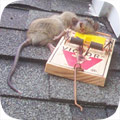 |
|
| The common name of the species called rattus rattus is the Roof Rat. Sure, some people call it the Black Rat or the Citrus Rat, but Roof Rat is the most commonly used name. There's a reason for this name. This rat likes to run across your roof. They may
do so in the course of their nightly scavenging, but in reality, if you've got rats living in your roof, they're there for a reason, and it aint to eat the shingles. They're probably on the roof because they've found some holes there that lead into the attic, and rats love to live inside
warm, safe, dry attics. In the case ...click for more |
10.31.2004 - Flying Bat Photo
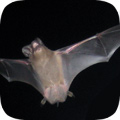 |
|
| WooOOOoooOOO!! Happy Halloween! I've come to suck your blood! I mean, I've come to professionally remove the colony of bats from your attic while everyone else has fun partying and trick-or-treating. This is
my best photo of a bat in flight thus far. I took it on a normal bat exclusion job. When I block bats out of their home - and remember, I don't trap or kill them - they swirl around, trying to get back in. They eventually
give up and go elsewhere, but not before I have a chance to get a snapshot of them flying about. Timing and focus are difficult for me ...click for more |
10.25.2004 - Raccoons in the Ceiling
 |
|
| This was a rare case of raccoon removal. There were raccoons in the house, which is not uncommon, but they were in an uncommon place. In almost
every case that I've dealt with thus far, the raccoons are in the attic. However, in this case, all the noise was heard in between floors, above the first story ceiling
and below the second story floor. There's not a whole lot of room in that space. However, critters have a way of fitting in tight gaps. I thought that the
animals would be rats, or maybe squirrels, based on the location. However the homeowners were hearing voca ...click for more |
10.24.2004 - Possum Photograph
 |
|
| I thought that this was a fine photo of an opossum. Possums are slow animals, and they have very tiny brains. They are not so smart. Thus, when they encounter trouble, sometimes they just kind of stand there. Sometimes they play dead, sometimes they open
their mouth and bare their teeth, sometimes they try to run away, sometimes they grimmace (really), and sometimes they ...just stand there. That's what this one did. I was tasked with catching it, since it was hanging around the property and not leaving, and the homeowner
was concerned that it might attack or ...click for more |
10.22.2004 - How to Find a Lost Snake in the House
 |
|
| I removed the above pictured snake from a residential neighborhood. Whether it was a lost snake or a released pet I can't be sure, but my later experience leads me to believe that it could well have been a lost pet, because
this one was a bonafide escape artist. This snake is a Boa Constrictor. I removed it and brought it back to my house so that I could hang on to it while I waited for a local snake
rescue and breeding group to come pick up the snake. I put the 5 1/2 foot snake in a large cardboard box and closed the top, sealing it shut with a laundry bas ...click for more |
10.22.2004 - Trapping Wild Animals of Orlando Florida
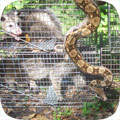 |
|
| Here's today's catch of wild animals in Orlando Florida. As you can see, I caught a large Boa Constrictor snake! I also caught two opossums and two raccoons. I got the Boa at a residential neighborhood yard, where the homeowners saw the snake slithering along.
I removed it for no charge. I got the first opossum from inside a garbage can - it had climbed in and couldn't get out! I snared it and put it into a trap. I got the second opossum from a trap that I set at the crawlspace entrance of a home.
I caught it with orange slices, which possums often seek out for the ...click for more |
10.18.2004 - Iguana Control in Orlando Florida
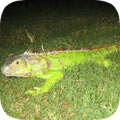 |
|
| Orlando is swimming with iguanas! They're coming out of the sewers! Marching in giant packs across our fields! Slithering across our highways! Invading our libraries and schools! Eating all of our crops! Scaling the roof of your home! Coming up through your toilet! Eating your children in the night! Well, these are exaggerations. They are merely nibbling at your children in the night. Still, there are iguanas in Orlando. I catch them from time to time. For example, I caught one today. There it is. In the above photo. Looking smart. This iguana was just sitting in the c...click for more |
10.14.2004 - One Way Door To Remove Squirrels
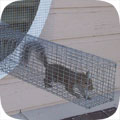 |
|
| One of the most common ways that I solve a problem with squirrels in the attic is via the use of a one-way door. The principle is simple: the squirrels
are going in and out of the house, through one of more holes that they've chewed open or that already exist. I find those holes and block up all but one of them, the most
heavily used one, and install a one-way door that will allow the squirrels to get out of the attic, but not back in. Sometimes, because squirrels are prone to chew on
wood to get back in, I use a one-way door with a cage attached, such as shown in the abo ...click for more |
10.14.2004 - Dead Possum Under Trailer Home
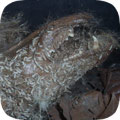 |
|
| This job was extra super duper hard and difficult and aggravating. In fact, dead animals under trailer homes make me angry. This job is always a bitch. In fact, it's pointless to say dead "animal" under a trailer home, because it's always "dead opossum under trailer home". The animal is always a danged opossum. I don't know why I'm complaining. It's not like I care about what the specie is. I guess maybe a little variety would be nice. But if the job lacks variety of animal, it doesn't lack variety in architecture, and this particular trailer home featured a very annoying ...click for more |
10.12.2004 - Rodent Trapping Techniques
 |
|
| I will now outline and discuss various rodent trapping techniques. When I say rodent, I'm talking about rats (many animals, from squirrels to beavers are members of the rodent family). I only really deal with rats inside homes. There's no way to stop them from
living outside. Within homes, the vast majority of the trapping takes place in the attic, because that's where the rats are, most of the time. Customers call me to complain about the
scurrying and running and scratching noises of rats in the attic. The customers don't, of course, hear the chewing on electrical wires, ...click for more |
10.07.2004 - Possum in a car engine
 |
|
| Wild critters get into all sorts of places my customers would rather not have them - in attics, garages, swimming pools, under porches, and so on. Well,
from time to time wild animals get into real zany places, such as this opossum in a car engine! The homeowner left his car parked for two weeks or so without moving it, and then when he tried to start it up, it wouldn't start. He said he noticed a faint odor,
but tried to start it again, to no avail - no power at all. He popped the hood and was in for a heck of a surprise when this toothy fellow lunged at him! The
opossum had ...click for more |
10.06.2004 - Baby Black Racer Snake
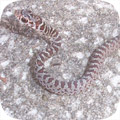 |
|
| Here it is. I probably get more emails about this snake than any other. This snake is incredibly common, especially throughout
Florida, and people see it, don't know what it is, take a photo, email it to me, and ask exactly what crazy new species of snake they've discovered. The answer is that it's a
baby Black Racer. I sometimes answer that it's a juvenile Black Racer or a hatchling Black Racer, but it's a baby Black Racer all the same. Many snakes change color and pattern
as they mature. I'm not sure exactly why, but my guess is that the color pattern on the babies is ...click for more |
10.02.2004 - How To Trap a Bat
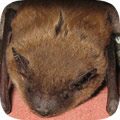 |
|
| What's the best way to trap a bat? It depends on the situation. If the bat is stuck inside the home and you merely want to get it out, then it's a simple matter - if you know where it is. If the bat is lying
still somewhere, then simply take a tupperware container, place it over the bat, and slide a piece of paper or cardboard or something thin underneath, and trap the bat in between the paper and tupperware. Then you can
carry it outside and let it go. Please do not kill it. Also, it's usually a better idea not to pick up the bat, because it might be rabid. Most of ...click for more |
09.22.2004 - Florida Cottonmouth Snake
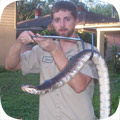 |
|
| Here's a Cottonmouth Snake (Agkistrodon piscivorus) that I caught in Orlando Florida. The Cottonmouth gets its
name from the color of the inside of its mouth, which is white, and which the snake often displays, with a wide open gaping, if threatened. It does not have rattles to warn of
its venomous bite. It is a member of the pit-viper family, which mostly consists of rattlesnakes. The Cottonmouth is a rare exception, and it's also unique because it is an
aquatic snake. It seems to prefer swampy areas the most, but also lives in and around most of ...click for more |
09.21.2004 - Dead Dog Under a House - How to Kill a PitBull
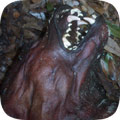 |
|
| I was called out regarding a bad smell under this house - a dental lab, to be exact, where they make dentures and such. I arrived and asked the usual questions, such as, "When did you first detect the odor?", and "What part of the house smells worst?", and "Do you think you can give me a good deal on porcelean crowns?". The lab tech motioned to the southeast part of the house, and said that he thought it was a dead opossum. He seemed distracted and intent on clearing up his supplies. I started to get ready, with my Tyvek suit and gloves and HEPA mask a...click for more |
09.20.2004 - Armadillo Hunting in Florida
 |
|
| I am an armadillo hunter. There are two types of armadillo hunters. One is a slack jawed yokel who stalks these critters from the back of
a beat-up pickup, shoots it with a 12-gauge, has his dillo hound retrieve the carcass, brings it back and roasts it up for supper, drinks a little moonshine,
and scratches the rosy area between his shoulders and head. The other type of armadillo hunter is an educated professional who sets humane cage traps, removes
the animal in a timely manner, relocates it to wilderness areas, and goes off to a sophisticated dinner of poached ...click for more |
09.18.2004 - Florida Gopher Tortoise
 |
|
| I simply found and photographed and then released this fine specimen. The Florida Gopher Tortoise, Gopherus polyphemus is, like most torti, slow. However, unlike most tortoises, it can dig really f'ing well. It digs these amazing
burrows, which are like, fifteen feet deep or more. Several wildlife species, such as the rare Indigo Snake, use these burrows for refuge. Unfortunately, the Gopher Tortoise is in trouble. As usual, habitat loss is the problem. There's a lot of land development
here in Florida, and much of the land previously used by the turtles is now ...click for more |
09.15.2004 - Albino Rat Caught on a Snap Trap
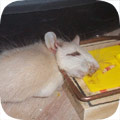 |
|
| Wow, an albino rat! This was my first and likely only albino rat of my career. I've caught over 1000 rats in my time so far, both with lethal and
live traps, and I've never seen an albino rat before. Sure, white rats aren't terribly rare, especially the white Norway Rats that people keep as pets, but this rat was a
true naturally-occurring albino rat. Albinism is a hereditary condition, caused by a lack of melanin pigments. It's usually passed on from recessive genes from
both parents. Albino genes are often weeded out amongst wild animals, particularly if the animals rely ...click for more |
08.23.2004 - Pet Raccoon
 |
|
| I probably get two or three requests per year for raccoon babies that people want to keep and raise as pets. I mean, just look at how cute they are!
How darling! Your grandaddy told you that he kept a raccoon as a pet, and it was great! Who can resist that black mask and that ringed tail and those cute little
hands? I do admit, I handle a lot of baby raccoons that I get out of attics, and they are just about the cutest animal alive - cuter than kittens or puppies, and they
make the most darling noises. Just look at it cuddling on my lap. Irresistible. Great then! Just the pet you ...click for more |
08.21.2004 - Florida Bat Removal Project
 |
|
| I faced many challenges in this bat removal project. One of the most common problems in bat control lies in reaching the bats. Since they can fly and I cannot, they can easily reach places that I cannot
easily reach. In this case, the bats chose to roost in the barrel tiles of this roof, in several areas, including the towers. In order to reach the towers, I had to bring ladders onto the flat roof portion. Interestingly,
I had to navigate them up a spiral staircase. Once I got the ladders on the roof, I faced the second challenge - tiles. Tiles are always a pain. I basically have to ...click for more |
08.16.2004 - Squirrels in the Soffit
 |
|
| Squirrels are the most common animal, nationwide, to break into houses. They will use an open hole or chew their way in, and live inside your house, which
is dryer and safer than any tree. I'm currently working on removing a group of four or five squirrels from a home here in Orlando. They are mostly living in the
soffit area of this home. The soffit, if you are unfamiliar with architecture, is the bottom portion of the eave (the underside of the part of the roof that hangs over
the edge of the house. Most homes have soffits. Squirrels just love to live in them. They provide plenty of ...click for more |
08.12.2004 - Legless Lizard
 |
|
| This is an Legless Lizard, often referred to as a Glass Snake, although the true name of this reptile is the Eastern Glass
Lizard. What's that you say? I'm wrong you say? You know a snake when you see one, your granddaddy taught you what is and what is not a snake and he'd say that this is a snake,
you say? Well you, and your granddaddy, are wrong. It's a lizard. It just so happens to have the same body design as a snake. This is similar to the way a dolphin may be a
mammal, but looks more like a fish, because having smooth skin, a torpedo shaped body, flip ...click for more |
08.03.2004 - Kittens in the Attic - How To Get Them Out
 |
|
| A female feral cat, like any other wild critter, wants a safe place to have her young. So pretty much every time (but not 100% of the time), when I have a call for cats in the attic, there's also some kittens somewhere. It's important to
find the kittens, and to check the female cat, if you've caught her without kittens, for swollen cat-teets, which indicate nursing. Believe it or not, kittens drink milk. Who would have thought? So in this case, I searched and searched for a litter of kittens,
and sure enough, I found them, huddled in a ball in the insulation. They looked cute! But ...click for more |
07.28.2004 - How to Get Rid of Mice in the Attic
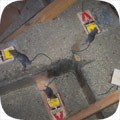 |
|
| Most people object to mice in the attic because they hear the noises of the mice every night, running around in the attic, and scratching. Mice also chew on wires or pipes, and they defecate and urinate a lot, and can spread disease. With time, they can destroy
an attic and make it unsanitary, and they eventually come down the walls and find a way into the house, where they'll break into the pantry and chew on and contaminate food. The sooner the problem is solved, the better. I'm going to examine the steps necessary to getting rid of mice in the attic:
Home Inspect ...click for more |
07.12.2004 - Do Snakes Chase and Eat Other Snakes?
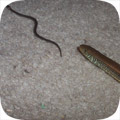 |
|
| I plan to make this my worst snake blog page of them all. There's really no point for it whatsoever, except to showcase the above photo, in which a large snake appears to be chasing a small snake. I say "appears", because first of
all, that's a legless lizard chasing the small ringneck snake, and second of all, it's not chasing at all. I simply put both of these snakes on the carpet at the same time, and they wound up in this configuration. In nature, it's possible that the
legless lizard would in fact eat a small Ringneck Snake like this, but of course, once critters are captured ...click for more |
06.20.2004 - Vent Repair to Keep Squirrels Out
 |
|
| Attic vents are a common wildlife entry point, particularly for squirrels and rats. The above photos were taken at two different homes, one of which had a
squirrel problem, and one of which had a rat problem. The rodents were entering the attic through improperly screened vents. You can see in the photo on the right
that this vent used to have a screen of some kind, but it was very flimsy, and it eroded with time. Rats were able to easily climb right into the attic. I sealed off the
vents with a heavy-duty steel screen. In the photo on the right, squirrels were seen ...click for more |
06.09.2004 - Armadillo Capture by Hand
 |
|
| I captured this small armadillo by hand. I was at an armadillo trapping job, when I noticed this dillo scurrying through the underbrush. I
chased after it, and despite its attempts to escape via short and quick erratic hops, I was able to get my hands around it and pick it up. I don't think I would
have been able to do so if this were an adult armadillo. The young ones have a softer, more flexible shell, as you can see in the above photo. Adult armadillos
have much harder shells, and thus are hard to hold. In addition, adult armadillos are much heavier and stronger and also ...click for more |
06.08.2004 - Raccoon Damage - Wall Torn out At Apartment
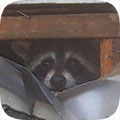 |
|
| This was a very interesting job. I got a phone call from one of the apartment complexes here in Orlando that I regularly service. They usually have
problems with squirrels getting into the attics of the buildings. Thus, when I got yet another call for noises in the attic, I went prepared to do a squirrel removal job.
When I got on the roof of the 3-story building to inspect, I saw this! There was a large hole torn into the wall of the apartment at roof level, with a big wooden board
missing. A tenacious female raccoon had climbed 3 stories up, which wasn't an easy climb ...click for more |
06.06.2004 - Eastern Mole Control
 |
|
| The Eastern Mole (Scalopus aquaticus) is common throughout most of the eastern United States, from Canada all through Florida. This little critter only grows to about 6.5 inches in total length, and 3 oz. in weight. It has no ears or eyes,
as you can see in the above photo, but it may be able to detect light. Moles, of course, live underground, where they dig a network of tunnels. They burrow through the soil in search of earthworms and grubs, and they can dig very quickly. They are very energetic, and
they eat a lot, about half of their body weight each day. ...click for more |
05.25.2004 - Animal in the Wall
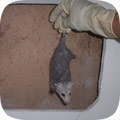 |
|
| If you hear scratching or clawing in your wall, and you think there's an animal stuck down there (what else could it be? A wall gnome?) it's best to take
care of the problem as soon as possible. Many wild animals are excellent climbers, but most homes feature drywall, which is pretty slick and hard for most critters to
climb. Thus, if you don't do anything about the problem, the animal is either going to scratch and chew its way out of the wall and into your home, or it's going to die
down there, and the odor will not be pleasant. Today I went to a house at which the ...click for more |
05.22.2004 - Removal of a Peacock from a Roof
 |
|
| Here in Florida we've got a few resident populations of peacocks. One of the flocks lives in one small specific area in Conway, off of
Michigan Road. I'd get calls all the time about these peacocks, with numerous requests to remove them. I couldn't really do anything about it, but I did
manage to keep them off this particular roof. They always roosted on this roof, and since they're a large and proud bird, they made a hell of a lot of
noise, and it bothered the homeowners a great deal. I installed a special motion sensitive squirt-gun device on the roof. Anything that ...click for more |
05.21.2004 - Rodent Removal
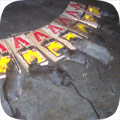 |
|
| I got this haul of rats at an apartment complex that I work for here in Orlando. The key to rodent removal is to seal off the openings that rodents use to
gain access to a building, and then to set the proper types of traps in the most effective manner. The reason the entry/exit holes must be sealed is because if you don't
seal them, the rats will continue to come and go as they please. Even if you do catch some rats, new ones will keep using those holes, which are now marked with rat
pheromone scent. Once you seal the holes, however, the rats that are stuck inside now ...click for more |
05.07.2004 - Wildlife Management In Orlando Florida
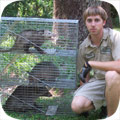 |
|
| I don't often describe my job as a wildlife management specialist, but apparently that's what some people call it. I suppose wildlife management is synonymous with wildlife control, which is a term I use more frequently. I will talk about my
wildlife management work in the state of Florida, but most of all, I want to talk about my awesome hair in this photo. It's like, all awesome and Prince Valliant and rocking.
I like the blonde highlights and the poofiness and everything that makes it the best wildlife management hair ever, hair that is capable of slaying ten or ...click for more |
04.27.2004 - What Bait to Use to Trap Armadillos
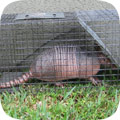 |
|
| Everyone wants to know what bait to use to catch armadillos in cage traps. After all, it's easy to use peanuts to catch a squirrel, or
cat food to catch an opossum, or marshmallows to catch a raccoon, so surely there's something that we can throw into a cage trap to catch an armadillo. I
shall now examine the various baits that I've heard recommended: Earthworms: Armadillos eat earthworms, it's true. So I've heard the recommendation of using earthworms for bait. However, this is tricky, because
earthworms tend to be smaller than the bars of a cage trap, ...click for more |
04.15.2004 - Solve This Bat Problem
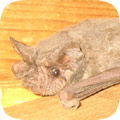 |
|
| I took this photo at a bat project last night, in which a lawyer's building was filled with over a thousand bats. To my great surprise, the owners of the firm left the problem go for many years until they
read a story about a lawsuit filed in Connecticut over contraction of histoplasmosis from bat droppings in a public building. Then they wanted to kill the bats, until they were informed that this could result in fines
from the Florida Wildlife Commission. Finally, they decided to pay to have me remove the bats carefully and properly. Some say the lawyer's hearts grew three ...click for more |
4.14.2004 - Attic Restoration - Fix and Clean the Attic
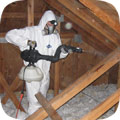 |
|
| Attic restoration is the term often used in the nuisance wildlife control industry to describe the process of restoring an attic to its original state after it has been inhabited and soiled by wildlife. So for example, in this case, a family of squirrels lived in this attic for years, and created a big mess within, by bringing in a great deal of nesting material, and also leaving behind a lot of waste - both droppings and urine, which I could easily smell. The problem with the nesting material is that it creates a potential fire hazard. It's all flammable plant material, and of course it's ...click for more |
04.13.2004 - Dead Opossum Under Mobile Home
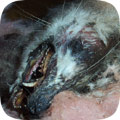 |
|
| I was very proud of this dead animal removal. The homeowners had called out a different company first, but they could not find it. They actually called two other companies, but the one guy was too fat to even get under the house, where the animal clearly was. Granted, the access hole was very small. I squirmed my way through the hole and started to crawl around. I had very little room because of the very large ductwork lining the area. I basically had to navigate my way through a maze of pipes and ducts, with no light, a bad smell, giant deadly spiders that w...click for more |
04.11.2004 - Banded Water Snake
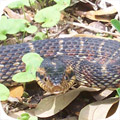 |
|
| This is a Banded Water Snake (Nerodia fasciata). I have photographed it outside of its usual aquatic habitat. I was called to remove a snake from a home, and I was told that I'd be extracting a
Cottonmouth. I arrived at the house and was directed to the ornamental pond in the front landscaping, and sure enough, there sat the above snake, a species that I had
never seen before. It looked a bit darker in the rocks and water, and like most water snakes it had a thick body. I captured it with my snake tongs, and it struck
several times as I transferred it to my snake bag ...click for more |
04.05.2004 - Pet Squirrels in my Pockets
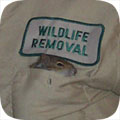 |
|
| Two darling baby squirrels. I removed them from a squirrel nest in an attic, along with the mother squirrel. It's a bit late in the season for
squirrels this young, but one can't always count on Mother Nature to deliver on schedule. One can count on Mother David to deliver a fine resting place for baby critters
- in my pockets! I will name them Scroungy and Scritchy. They are very cute, nestled up in my pockets and fondling my nipples. I think I'll keep them as pets
forever. On second though, no I won't. Squirrels aren't meant to be pets. Yes, they can be cute, and ...click for more |
04.01.2004 - Raccoon Eyes - Tapetum Lucidum Effect
 |
|
| This is a photo of a mother raccoon and two of her baby raccoons. The babies have grown to a decent size, and are about ten weeks old at this point.
I removed them all from the attic of a home. I actually removed the young raccoons manually, with a snare pole, and then set one each in the back of two traps. The
mother went in the trap to get her babies, and I caught her. I then reunited them all. In this photograph, the young are clinging to mom, and I took the photo of
all three together. In people during photographs, the light of the flash will often reflect against the ...click for more |
03.29.2004 - Rat in the Ceiling
 |
|
| This is one of the most common jobs that I do - removal of rats from the ceiling of a home. The phone call always starts out the same: "I hear noises in my attic!". I then ask the customer to describe the noises. Several different animals live in attics, but if
the description is of a quick scurrying, the pitter-patter of little feet, and particularly up the walls in addition to the ceiling, then I know it's rats. The primary problem that people have with rats in the ceiling is the noise. However, people don't know about the other
dangers of having rats in the ceiling. Rats are rodents, and ...click for more |
03.28.2004 - Snake Shedding - About to Shed
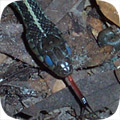 |
|
| I got a call about a snake in someone's flower bed, and the lady said, "It looks like it's from Village of the Damned"! It has
glowing blue eyes!" I arrived on the scene, and found out that she wasn't in fact crazy. This snake DID have glowing blue eyes. In fact, the entire body was fairly blue.
This isn't terribly surprising, seeing as how this snake is a blue-phase Eastern Garter Snake, which is a common species here in Central Florida. Shortly before shedding, the
skin becomes cloudier, and if it's tinted with color, that color is more pronounced. The color shows up a little ...click for more |
03.24.2004 - Dead Animal Under House - Bad Smell Removal
 |
|
| This is a very typical dead animal removal scenario here in Florida. Because of the high water table, the houses here do not have basements. Many homes have foundations flush against the ground, but many are elevated off the ground, with a crawlspace underneath. These areas are magnets for wild animals - they provide a safe refuge from the elements and a good place to set up a den. Opossums in particular like to live underneath houses. Opossums don't live very long - about 2-3 years in the wild. They're very common around here, and they simply d ...click for more |
03.20.2004 - Orlando Florida Snake Charmer
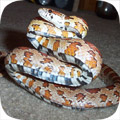 |
|
| Here is a fine photo of one of my favorite snakes, the Corn Snake. This is a fairly small specimen, but it's just as pretty as any of them. It's got
beautiful auburn scales with orange spots, lined in black. The belly has a black and white keyboard pattern, which ye people of olde likened to maize, and that's how this
snake got its name. I sometimes like to play with the snakes I catch, and so I used my expert snake charmer techniques on this snake. I twirl and wiggle my finger in a
certain way, and the snake watches, mesmerized. I bring the finger closer, closer, and ...click for more |
03.10.2004 - Skunk Control
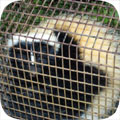 |
|
| This is not a photograph that I took. Someone else took it for me. The reason is because I don't get any skunk calls here in Orlando Florida.
It's too bad. I like skunks. I even like their scent. I have a thing for skunk scent. But I haven't smelled it down here, not even on the highways.
Up north in Pennsylvania, where I grew up, skunks were common, and every few miles down the road I had the pleasure of sniffing one. Alas, such is not the case here.
I did do a fair amount of skunk control and trapping while I was training as a wildlife removal specialist in ...click for more |
03.04.2004 - How To Stop Armadillo Digging
 |
|
| This is a photo of a Nine-Banded Armadillo digging a fresh burrow. I came across this animal while on an armadillo trapping project. Dillos
usually dig several burrows within their home range. I'm not sure how many, but the number may be from 10-20. They usually have a primary burrow or two in
which they sleep - and armadillos sleep about 20 hours per day. These big burrows are straight and deep, and may have a chamber at the end. However, most of
the burrows that armadillos dig are merely short-term escape tunnels, in case they need to bolt from danger. Fact...click for more |
02.22.2004 - Bats in a Barrel Tile Roof
 |
|
| Here we have a Brazilian Free-Tail bat flying out of one of its favorite natural habitats - the Spanish-style, Barrel-tile, Makes-me-smile roof. But mostly it makes me frown, because it's a pain in the butt
to get the bats out and seal every last tile. Down here in Florida, fancy multimillion dollar homes like this one have barrel clay tile roofs. The tiles look fancy, they deflect heat, they attract bats. Bats, especially these
free-tail bats, just love to live in barrel tile roofs. I've read that the Brazilian (also known as the Mexican) Free-Tail can tolerate heat up to 140 degrees, but it must ...click for more |
02.21.2004 - Squirrel Infestation
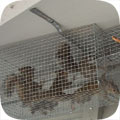 |
|
| I made this squirrel trap myself, and I was pleased with the results. This customer had a squirrel infestation in his ceiling. There was no attic
space to access inside this flat-roof home, but he was hearing all sorts of running noises throughout his ceiling space. I inspected the home yesterday and found that a
large chimney flu pipe runs up the side of the house and through a hole cut into the soffit of the house. The problem is that the pipe had a diameter of 16 inches and the
hole had a diameter of 22 inches. This left a big open ring leading right into the ...click for more |
02.20.2004 - Snake Powder Spray to Keep Away Snakes
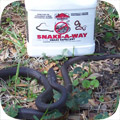 |
|
| "Can't you just put out some sort of a powder or spray to keep away snakes?" I hear this question on a fairly regular basis. I
know that there's a market for such products. Many people simply can't stand snakes, and harbor a real phobia regarding them. And where there's demand, there's products sold to
meet that demand. Alas, so far I have tried every one that I can find, in multiple scenarios, and I am absolutely convinced that none of them work. As a wildlife removal
specialist working in central Florida, I have the opportunity to work with unwanted snakes and in ...click for more |
02.19.2004 - Professional Pigeon Project in Orlando
 |
|
| This gift store in Orlando, on International Drive, had a pigeon problem. The pigeons were roosting on the steel beams that held up the
decorative (not functional) Space Shuttle. This of course means that they pooped all over the ground below this area, right near the front door. Thus, all
of the customers who entered the store had to walk through pigeon poop to do it. Patronage was dropping. Sales of gifts were dropping. Profits were dropping.
All because pigeon droppings were dropping. So, the owners called me and asked if I could make the pigeons go away. I said that I ...click for more |
02.18.2004 - Dead Mouse in Attic - Rotting Mice
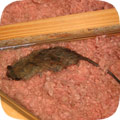 |
|
| The problem with dead mice in the attic is that they are hard to find. This is because they love to burrow, and they dig their way down into the insulation. So when they die, they're already buried down in some tunnel. This is often right against the drywall ceiling, so the smell seeps down into the house and creates a strong odor within. However, when I go into the attic to search for the dead mouse, I barely smell anything, because the odor is blocked by the insulation, and the strong air flow in the attic, due to the ventilation, prevents much of the smell from building up...click for more |
02.09.2004 - Mole Trapping
 |
|
| If you have a problem with moles destroying your yard, there is only one way to get rid of the problem - with mole traps. There is absolutely no effective
mole poison, repellent, deterrent, or any device to easily get rid of them. Except for a trap. Just set the mole trap on the surface mole tunnels, trap and remove
the mole or two in your yard, and you'll have digging no longer. Unfortunately, mole trapping is not easy. The traps are not very user friendly. There are
several types of mole traps, from harpoon to scissor (shown above) to underground clamp traps, but ...click for more |
02.04.2004 - Urban Pigeon Removal at Water Park
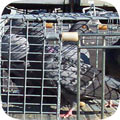 |
|
| This is an example of an urban pigeon removal job that I performed at a water park here in Orlando FL. You can see the water slides in the
background of this photo. The water park, Wet-N-Wild, was concerned about the presence of pigeons in the park. They were a constant nuisance - not only flocking
around the park and eating scraps left by park visitors, but most of all, nesting on the buildings and leaving behind nesting debris, feathers, and of course,
the big problem - pigeon droppings. The droppings were unsightly and unsanitary. Pigeon poop is primary...click for more |
02.03.2004 - Remove Raccoons in the Wall
 |
|
| This was a very challenging job. The homeowner knew she had a raccoon in her attic. She'd called another company to take care of the problem, but
they told her that it'd be a minimum of $2000 to solve the problem, and that they'd set traps on the ground outside the house. I know that if a raccoon is in the attic,
it's going to be a female raccoon with babies, and that traps on the ground will not solve the whole problem. There's 3-4 baby raccoons somewhere in the attic, and they
must be removed, or they will starve and die without their mom. I was hired ...click for more |
01.29.2004 - Pigeon Exclusion - Get Pigeons Out of Building
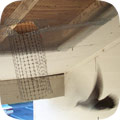 |
|
| I was called out to this apartment building because it had a problem with pigeons roosting in the attics. Many of the apartment units had
these large square openings in the stairwells. The openings led right into the roof and attics of the apartments. Pigeons eventually found these openings, and
they provided access to a perfectly safe habitat - the attics. Many pairs of pigeons had established nests in the attic space. This caused a number of problems.
First of all, the tenants of the apartments had to deal with a lot of noise coming from up above - this noise was ...click for more |
01.25.2004 - Does Bat Trapping Work?
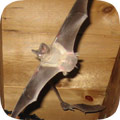 |
|
| No, bat trapping does not work. At least, it's not a good way to handle a bat problem. Trapping bats is like, I don't know, using a lighter to cook dinner. It's just a dumb way to do it. No wait, trapping
bats is like using a Cuban Cigar to cook dinner - dumb and probably illegal. It's true that many, if not most, nuisance wildlife species are controlled via trapping. If you've got a raccoon in your attic, you've likely
got to set traps to catch it and remove it from the property. However, bats shouldn't be trapped. Some uninformed companies practice bat trapping, and bat traps are ...click for more |
01.19.2004 - Alligator Removal in Orlando Florida
 |
|
| As a wildlife removal specialist working in the state of Florida, I hear the same initial reaction from northerners again and again. When I tell that what I do for a living, the first thing out of their mouth
is, "Wow, so you mean, you trap gators and (stuff)?" Gators, gators, gators, that's all anyone cares about, is gators. No doubt the sensationalist stylings of Steve Irwin the Crocodile hunter, and other such critter mavericks
on TV have taught people to think that every fellow who dons a khaki shirt and goes after wild animals is wrestling six gators before lunch. The ...click for more |
01.13.2004 - Animal In the Wall - Opossum
 |
|
| This was a very interesting job. I arrived at a home to inspect for animals in the attic. The guys living in the house said that they heard all kinds of
walking and scratching in the attic. The first thing I did was an external inspection of the house and
roof. I couldn't find any area that animals could use to get inside. Yet when I entered the attic, I saw lot of tracks and tunnels and opossum droppings. I was doing my attic inspection, when I thought I heard a noise coming from down one of the walls. I was able to peek
down the wall from the attic, and there was the culprit ...click for more |
01.06.2004 - Orlando Wildlife Rehabilitation
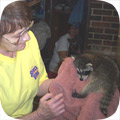 |
|
| I'd like to introduce you to a wonderful woman. Her name is Lee Harr. For more than ten years now, she's operated a wildlife rehabilitation facility out of her own home. She pays all of the expenses out of her own savings. Her goal is
to care for injured, sick, and orphaned wild animals. From raccoons to squirrels to birds and almost anything, she has a wonderful gentle touch and understanding of wildlife, and a relentless drive to help wild critters. She works non-stop, 16 hours a day,
seven days a week, and she absolutely loves animals. She takes a no-nonsense ...click for more |
01.05.2004 - Squirrel on a Rope
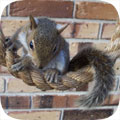 |
|
| This is a small squirrel, perhaps six weeks old, that I removed from the bottom of a chimney. I lowered this sisal rope down the chimney, and it clung on,
and I just pulled it up, like reeling in a furry fish. It clung on to the rope, and I was able to take a few good photos of it, such as this one. Sisal rope is a
good tool for removing squirrels from chimneys. I carry a few lengths of it with me at all times, and I weight the end with large lead fishing weights. It's a
common problem here in Florida for squirrels to fall down chimneys. This is normally not a problem in most parts of ...click for more |
01.04.2004 - Removing a Squirrel from a Chimney Flu
 |
|
| This customer was hearing squirrels in his chimney. The problem was that he had a slick metal flu, a tube as you can see in the photo behind my left arm.
Some squirrels had made a nest up at the top of the flu, under the rain and debris guard (not pictured, since I've removed it). This wouldn't really be a problem, but a
female squirrel made a nest, and one of her young squirrels, once it got the knack for running about and exploring, decided to explore its way down the chimney flu, where it
got stuck. Once down there, it made a hell of a racket, desperately tryin ...click for more |
01.02.2004 - Snake Tongs - Snake Catching Tool
 |
|
| I'm seen in the above photo holding a snake that I caught with my trusty snake tongs. This is basically a snake catching and handling tool that consists of a gripping end on a pole, and a lever
handle. The one in the above photo is actually an earlier model of tong, and I've replaced it with the much better Gentle Giant by Midwest Tongs. A good set of snake tongs should be strong and lightweight, and the most important part is the
gripping end. It should be broad, so as to distribute the grip across a wider area and thus hold the snake more gently. Also, it should be ...click for more |
12.31.2003 - Bobcat Trapping
 |
|
| I set armadillo traps at a house in a suburban community on the east side of Orlando. I had trapped an armadillo already, but the customer wanted me to continue trapping, in case there were more. The yard suffered from significant
armadillo digging. I got a call on the morning of the 31st, from the owner of the house, and she told me that one of the cages contained a large and aggressive cat. "I think it's a bobcat", she said. "SuuurreeÖ it's a bobcat", I thought. The customer
is always telling me about wild and crazy animals that do not exist. Every harmless little Corn Snake ...click for more |
12.29.2003 - Rodent Trapping in a Cage
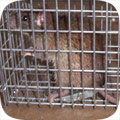 |
|
| Wow! Here's a first! A Roof Rat and and Eastern Gray Squirrel in one cage! I was called out to a home that had scratching in the ceiling. Most of the noises were heard in the morning and evening, so I suspected that it was squirrel
activity. I inspected the home, and found multiple entry points at the eave gaps and in holes chewed in the soffit. I sealed up the entire home and installed heavy-duty steel screen on the soffit areas, so that no more squirrels could get in. I left
the two primary entry holes open, so that I would not seal any animals inside (where they'd desperately ...click for more |
12.14.2003 - Animals Gnaw on Electrical Wires
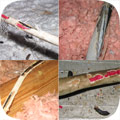 |
|
| One of the greatest dangers of having wild animals living in your attic is that they can cause destruction, in particular, to electrical wires. Many
animals like to gnaw and chew, but most cases of wire destruction are from rodent species - squirrels and rats. I have been in thousands of attics so far in my career as
a wildlife removal specialist, and a good percentage (more than not) of the houses with rodent infestations have some extent of chewing on the electrical wires. The four
photos above represent just a few of the cases I've seen so far. A rodent is ...click for more |
12.05.2003 - Rat Poop Droppings & Waste in Attic
 |
|
| Here are two different photos of rat poop in an attic. On the left is a heavily-used rat pathway in an attic with blown-in fill insulation. On the right
is a section of scattered droppings in pink insulation. Both attics had a heavy rat infestation, and thousands of droppings scattered throughout. Rats have very
high metabolisms, and they poop a lot perhaps about 20 rat turds per day. Thus, they leave a lot of rat waste in the attics where they live. They also urinate, and the pheromone scent in the
urine and perhaps even the poo attracts new rats to the area. There is one ...click for more |
12.01.2003 - Stray Cat Trapping
 |
|
| Nothing in my industry of nuisance wildlife control incites more controversy than stray cat control. The problem is that cats, (Felis catus) exist in basically two forms. There's the domesticated housecat and beloved pet, and then there's
the stray, or feral, cat which is often, for all intents and purposes, a nuisance wildlife species. I've observed many feral cats, living under dumpsters, in the woods, junkyards, and other unsavory places, and their behavior is no different than that of raccoons, opossums,
or rats. In fact, the cats are usually dirtier and more aggressive. The ...click for more |
11.21.2003 - Eastern Gray Squirrel
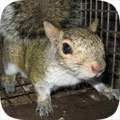 |
|
| This is an Eastern Gray Squirrel, a common critter throughout the United States, and a common pest critter found in people's attics. These highly capable
and adaptable animals are able to thrive in the woods and in the suburbs and even the middle of the city. They live in trees, attic, anywhere they can find a safe place
to den. Thus, they commonly come into conflict with people, who wish to have them removed from the attic or property. I will now address some recent emails
that I've received about squirrels. Dear David, We found a baby squirrel that came right up ...click for more |
11.20.2003 - Pigeon Control BB Gun Shooting
 |
|
| Most of the time, pigeon control is done via the installation of deterrent devices. So for example, if pigeons are roosting in an undesirable
area, I can install a deterrent such as bird spikes to prevent them from nesting in that area. In addition, at times I can set special pigeon traps to trap and
remove the birds. However, in certain situations, lethal control is the only answer. This type of pigeon work is fairly common in the industry. If pigeons
are scattered about in a facility, and it's unfeasible to install deterrents, and the conditions don't allow for trapping and the trapped ...click for more |
11.12.2003 - Animal on the Roof - Trap and Remove
 |
|
| This was yet another case of an animal in an attic. The customer called me, and was hearing all sorts of running and walking noises in the attic, with
most of the activity coming at night. From the description of the problem, it sounded like a larger animal, as opposed to rats or squirrels. Larger animals most
commonly include raccoons and opossums. I arrived at the house and began my inspection. It wasn't hard to find that a large hole had been torn right into the roof.
At this point, I knew that I was dealing with a raccoon. Only raccoons are strong enough to claw and ...click for more |
11.08.2003 - Florida Boa Constrictor
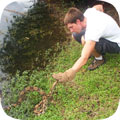 |
|
| Florida is home to many non-native species of plants and animals. People seem to become particularly excited about the presence of non-native snakes. It's true that Florida is host to several species of foreign snake. The subtropical climate
allows for survival of certain species that usually only live in jungles in areas such as central and South America, such as snakes. One such snake is the Boa Constrictor. This is a very well-known snake, and is a member of the python family. It's not nearly as
large as the Reticulated Python or the Anaconda, two of the largest ...click for more |
11.01.2003 - How to Remove a Dead Animal in the Attic
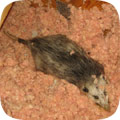 |
|
| I get a lot of phone calls for the removal of dead animals inside houses. Such an even causes a very strong odor inside the house. Sometimes the
smell is so bad that the inhabitants cannot bear to live in the house any longer. If the person in the house realizes that the source of the stench is from a dead
animal that is decaying, they can call me, and I'll come and remove the rotting critter. The animal could have died in a variety of places - under the house, in
the wall, or so on, but oftentimes the dead body is up in the attic. If I determine, based on my analysis of the house arc...click for more |
10.29.2003 - Mouse Caught in a Cage
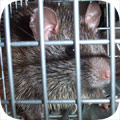 |
|
| I caught this mouse in a cage today. The customer had a problem with scratching noises in the attic, running and scampering noises at night, in the walls and ceiling. I was called out to investigate. When my inpsection of the attic yielded a mouse infestation, the
customer seemed crestfallen. "I don't want to kill the mice!" she said, "can't you just use some sort of mouse repellent?" I told her the truth, that there's no such thing as an effective mouse repellant. Many are sold online, and most of them consist of some sort of flakes or powder,
most likely composed of ...click for more |
10.25.2003 - Bat Removal In Miami
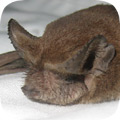 |
|
| This is a fine close-up photo that I took of a Brazilian Free-Tailed bat that I removed while on a bat control project in Miami, FL. They are not nearly as cute as the other common Miami bat, the Evening Bat. Notice
the simian brow ridge, the pig-like nose, and the bristling whiskers all about the paunchy face. Yet, the mother bats still take care of the young. Isn't nature a marvel! This particular bat was one of many that I
removed from a Miami apartment complex. Most are removed without being touched, but this one accidentally made its way into the home, got in ...click for more |
10.24.2003 - How To Vacuum the Attic to Get Rid of Animal Waste
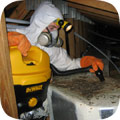 |
|
| This attic was infested with rats. They left thousands of droppings throughout the attic. The homeowner wanted his attic cleaned, but did not want to pay for complete insulation replacement. Thus, I cleaned the attic manually. It involved several steps. The first is to physically remove as many of the rat droppings as possible. This attic had rolled-out BAT insulation, which is easy to vacuum, unlike the blown-in loose fill insulation. In the above photo, we see that I'm vacuuming rat droppings off a duct and into a small portable vaccum. This type of vacumm is good for use in a...click for more |
10.21.2003 - How to spell "Snake"
 |
|
| I caught this young Black Racer snake today. As you can see, the baby racers look nothing like the sleek black adults. They have maroon patterns and speckles. I had a squirrel in a trap, and just out of curiosity, I put the squirrel and this
little snake together in a bucket. I figured that the little snake would pose no threat to the squirrel. I sure was correct! The squirrel instantly picked up the snake, bit it behind the head, and dropped it dead. It was amazing! I've never seen anything like it!
Had I known that the squirrel would have killed the serpent, I'd have never placed ...click for more |
10.17.2003 - Animals Under the House - Keep them Out
 |
|
| This is an older house in Orlando, built in the 1940's. Like many Florida homes, it is elevated off the ground to prevent water damage. It of course
has no basement. Most such homes have solid walls leading to the ground. They have vents, for airflow, but at least they have walls. Not this home. It
was simply an elevated home with no walls, and just a wide-open space leading under the home. It's no surprise then, that over the years this house has been a favorite
home to wild animals! Critters just love to live in a dry place, and an open home like this is ...click for more |
10.11.2003 - Raccoon Repellent
 |
|
| I get a lot of phone calls and emails asking about raccoon repellent. I respond to all of these emails explaining that there is no such thing as an actual effective raccoon repellent or deterrent. Many are marketed and sold. Some of the most common repellants
sold are simply mothball flakes. They don't work, they can actually make you sick, and they are bad for the environment. Ammonia soaked rags don't work either. I've tried, in some very tight quarters where I thought it might work, but it does not. Some other repellents are based
on predator urine. These can ...click for more |
10.06.2003 - Wild Animal Trapping in Orlando Florida
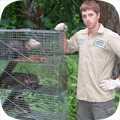 |
|
| I am most pleased to be a wildlife removal specialist in Orlando FL. I trap and remove nuisance wild animals from people's homes and property. Most commonly, I deal with raccoons, opossums, armadillos, squirrels, snakes, & bats. When it comes to catching
animals in large cages, such as shown in the above photo, it's mostly raccoons, opossums, and armadillos. In the above photo, I have a stack of four cages with raccoons, and one opossum. I caught the first raccoon at a house in which the raccoon was pooping in the customer's
pool. I simply set a ...click for more |
10.04.2003 - Baby Corn Snake Photograph
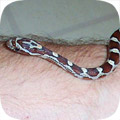 |
|
| This is a photo of a baby Corn Snake. When I first caught it, I was confused by the coloring. It did not match that of the
snakes I usually see. I concluded at first that it was an Eastern Milk Snake. However, with some more research, I discovered that it was a baby Corn Snake. Like many snakes,
the coloration of the juvenile snakes does not match that of the adult - it changes with age. In the case of the Corn Snake, the coloration and pattern changes significantly,
such that the adult is a beautiful golden color with darker orange markings. In addition, this juvenile ...click for more |
09.30.2003 - Possum Trapping
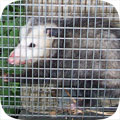 |
|
| Here's one of the nuisance critters that I commonly deal with. It's the Virginia Opossum. These animals are common in Florida. They are nomadic scavengers, though they will set up homes in and around human structures. Females will commonly live in attics in
the late spring and summer, if they have young. I've dealt with many such cases this past season. However, in the autumn, they are most just scavenging about, stocking up on food for the winter. Even though it doesn't get cold down here, it's still an instinct. This opossum was
living under a pool ...click for more |
09.17.2003 - Snake Emergency Snakebite
 |
|
| "Hello, 911? I've just been bitten by a venomous snake". That's a call I hope I never have to make, and to be honest, I
don't believe I ever will, because I'm armed with the most effective snake protection available - knowledge. While that may sound hokey, it's of course completely true. Since
snakes don't ever attack unprovoked, and since almost all cases of snakebite occur when an ignorant and inexperienced person attempts to handle a dangerous snake, I don't
expect to ever have a problem. However, I will offer advice to anyone who does receive a snakebite. ...click for more |
09.14.2003 - Catch Squirrels on the Roof
 |
|
| Here are two juvenile Eastern Gray Squirrels that I caught off of a roof. I do most of my squirrel trapping on roofs. Squirrels are very common pest
critters in urban and suburban areas, and they spend a lot of time of the roofs of homes. This is party because the roof is just another part of their environment, but
squirrels also often nest in various areas of the roof. If the roof provides some shelter in an area, such as an overhanging eave, chimney cover, awning, or other
structure, squirrels may end up nesting in those areas. I removed these juvenile squirrels who were in ...click for more |
09.13.2003 - Dead Rat in House - Died Chewing on Electrical Wires
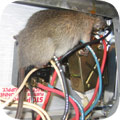 |
|
| I've encountered this scenario multiple times. There's a dead animal smell somewhere inside the house. I begin my search, sniffing the area. It's evident that the smell is the strongest in the kitchen. The homeowner knows this, and I can tell as well. However, what the homeowner doesn't suspect is that the dead animal is in fact in the oven. Not broiling in a pan for a Sunday dinner, but rotting in the rear panel with the electrical wiring. The first time I was called for such a job, I was confused as well. I searched the attic, I sniffed all of the cabinets and cupboards, the walls...click for more |
09.04.2003 - Big Bat Removal Project
 |
|
| This is my largest bat removal project so far - a large resort on Siesta Key, Sarasota. They had large colonies of bats living in these mansard style roofs. I, along with several other bat control companies
throughout Florida, came to the property to give quotes for the project. The project presented many challenges. First of all, the bats were entering and exiting the mansard roofs through barrel tile. These tiles make a
job much more difficult, because the entire surface of the roof, not just the roof lines, must be addressed. Barrel tiles leave gaps at every section where tile ...click for more |
08.29.2003 - Wildlife Trapping
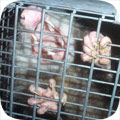 |
|
| "LET ME OUT!" bellowed the trapped opossum. "No!" I said. "YES!!!" hollered the critter. "Not until you're relocated to a state-approved wildlife preserve at least ten miles from your capture site!" I shouted. "OKAY!" said the opossum, "BUT COULD
YOU AT LEAST GIVE ME A CIGARETTE WHILE I'M IN HERE?" True story. I am a nuisance wildlife trapper by trade. I do not trap wild animals for the fur or the hides or the
meat or for fun. I am a professional wildlife control expert who solves problems between people and wild animals. This means that I do prevention, ...click for more |
08.23.2003 - Boa Constrictor caught in Orlando
 |
|
| I caught this Boa Constrictor here in Orlando Florida. An elderly couple called me about a large snake in their garage.
Usually, a large snake turns out to be a tiny three-foot imitation of a pencil. However, these folk weren't kidding! When I showed up, sure enough, there was one large snake
coiled up next to the lawn mower in the garage. I was actually confused about it at first. I wasn't expecting to see a Boa Constrictor out and about, and since I don't have
much experience with pet snakes, I didn't recognize it as a boa at first. I was unable to identify it, and tho ...click for more |
08.20.2003 - Opossum Poop - Droppings & Waste in Attic
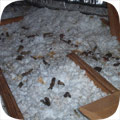 |
|
| Wow, this was a messy attic. Opossums had been living in this attic for a few months. The homeowner procrastinated doing anything until the noise
and the smell got to be too much to handle any longer. I came to the home and found several sections of a flimsy soffit screen torn open, and the opossums could easily
climb up adjacent trees and downspouts and into the attic. Opossums are messy animals, and they poop wherever they want. They poo a lot, and their terds are the size of a dog's turds. This
attic was filled, from end to end, with possum drop ...click for more |
08.11.2003 - Squirrels in the Eaves
 |
|
| This house has a family of squirrels living in the eaves. There's no attic space for me to access in this particular home, and the homeowner is hearing
most of the sounds coming from the perimeter of the home. It's the normal sort of report for a squirrel infestation. All sorts of scratching and running noises are
heard, they are often fast and rambunctious, and they happen in the morning and evening mostly. This is when squirrels are active. The squirrels have chewed some
holes in the flimsy vent areas underneath the eave. It's easy to trap them with this special trap - it's ...click for more |
08.08.2003 - Owl Removal - Stuck in Pool Area
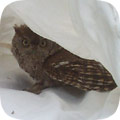 |
|
| I got a phone call from a worried homeowner who informed me that she had an owl stuck in her screened-in pool enclosure, or lenai, as we call
them here in Florida. I told her that I'd come out right away, so I did. I arrived, and found a small owl perching on the steel beam, as seen in the upper-left
of the above photo. It was still and sleeping. I have a special heavy-duty canvas net that I use for certain wildlife removal scenarios. I got the net. I
quietly sneaked up on the unsuspecting and sleepy owl. Then, with one swift and smooth swipe of the net, not unlike the one ...click for more |
08.05.2003 - Raccoon Poison
 |
|
| The above photo is of a raccoon mother gently picking up and carrying one of its babies in its mouth. I came across this raccoon today while I was driving
from one job to another, and I got this photo, so I decided I'd share it on my blog. I've been getting a lot of emails lately about the use of poison for raccoon
control. Raccoons do cause some problems for people, but if you have a raccoon issue, POISON IS NOT THE ANSWER. First of all, there is no legal registered poison for
killing any large mammal, including raccoons. Second, I don't know of any effec ...click for more |
07.15.2003 - Armadillo Pest Control
 |
|
| This is a photo of me and my armadillo pest control service based in Orlando FL. I caught this small armadillo from a customer's property.
It's a juvenile, so I am able to handle it with these thick gloves. Notice how the armadillo has a worn down spot on its head. This is because armadillos don't
hesitate to crash their way through brush, undergrowth, dirt, and even into hard objects. What armadillos lack in intelligence, they make up for in determination.
What they lack in their belly, they fill with invertebrates such as earthworms and beetle larvae. This is often why ...click for more |
07.11.2003 - Snake Sack - Bag for Snakes
 |
|
| Here I am, catching and removing a snake from a Florida property. There are many ways to catch snakes, from snake hooks, to tong (such as seen above), or by trap or by hand. But no matter how you catch it, you then need to transport it, so that you can
take it away from the property, keep it safe, and then relocate it without harm. The best way to transport snakes is in a snake sack, also called a snake bag. A bag holds the snake comfortably, and keeps it from squirming around. With no flat or hard surfaces, the snake really
can't push off and gain any leverage. A ...click for more |
07.08.2003 - Dead Raccoon Carcass Removal
 |
|
| This is a very simple dead animal removal. In fact, one might think that this is a very common sort of dead animal removal job. However, this was actually pretty rare. It's not very often that I arrive at a house with a dead animal that is simply lying outside. Most of the time I'm called because a homeowner smells a terrible stench somewhere inside the house, and it's my job to find and remove it. Removing the animal is always the easy part - the finding is usually the tricky part. I suppose that most of the time, if an animal is simply lying dead outside that the hom...click for more |
07.03.2003 - Wildlife Trapping in Orlando Florida
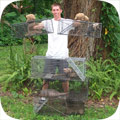 |
|
| If you need wildlife trapping in Orlando Florida, I'm your guy! I'm the rootinest-tootinest critter gitter in all of Florida, yee-haw! I've caught raccoons and squirrels, both boys and girls, from coast to coast, with taters and toast! I catch
them mangy musky muskrats, those skiving squirrels, and those tasty armadillos by the bucketload. I'm armed with a steel trap and an itchy snare pole finger, and I can smell a dead skunk from your mother in law with but one whiff of my bloodhound snout. It's late and I'm
tired and I'm just writing gibberish, because I want to go ...click for more |
06.27.2003 - Armadillos Invade Florida
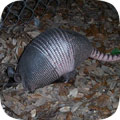 |
|
| The Nine Banded Armadillo, Dasypus novemcinctus is not native to North America, including the two states in which it most thrives,
Florida and Texas. The mammal is originally from south/central America. However, it has been transplanted to the states, and it survives just fine here. Rumor
has it that the species was introduced to Florida in the early 20th century when two armadillos escaped from a small zoo. Who knows. Usually, exotic, or non-
native species end up establishing populations in suitable habitats, because people invevitably transport the animals. In ...click for more |
06.22.2003 - Five Lined Skink
 |
|
| The Five Lined Skink, (Eumeces fasciatus), also known as the Blue Tail Skink, is a small lizard that lives throughout much of the eastern United States. Skinks are characterized by a lack of neck, a smooth tubular body, and short
legs. They squiggle along when they move. As either of their common names imply, this lizard has five bright lines tracing down its back and tail, and the tail is blue. The colors are more pronounced in younger lizards, and can fade with age, particularly in
the male lizards. I think this lizard is very pretty. It has the sort of fancy colours more ...click for more |
06.16.2003 - Dumb Possum - How Smart Are Opossums?
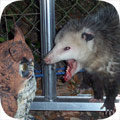 |
|
| I read in a wildlife book that the North American, or Virginia, Opossum has the smallest ratio of brain mass to body mass of ANY mammal in the world. I actually don't think that's true (armadillos for example seem to have teeny heads and big bodies),
but I certainly do acknowledge that the possum's brain can't be very large, and that the animal doesn't use much of what it does have. Opossums are dumb! They're so dumb that they let their ears freeze off in the winter instead of seeking shelter. They're so dumb that
I've chased them and they run into walls. ...click for more |
05.23.2003 - Armadillo Removal Tactics
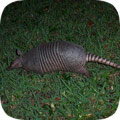 |
|
| I managed to capture this fine photo of an armadillo running along at night. Armadillos are nocturnal creatures, so they're not often
seen. When they are spotted, they are frequently rooting around, sniffing the ground for worms and grubs, and digging. I saw this armadillo sniffing the lawn
at a customer's house after dark (I work long days) and I quietly approached it. It ran away, but I ran along after it, and managed to take this photograph.
It's a nice looking (in my opinion) and relatively harmless animal, so why do people desire armadillo removal? The ...click for more |
05.11.2003 - Fix Hole to Keep Rats Out of House
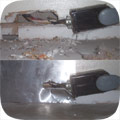 |
|
| Here's probably the most common place that rats use to get from the attic into the living space - the power supply for the kitchen stove. It's by far the
most common area of entry. The reason for this is because the power lines run up through the wall, and the rats in the attic will run along that power line as an easy
thing to descend and climb. A hole is always cut in the drywall to allow the cord to go through, and rats use that hole. If the hole isn't large enough, but rats
can smell that tasty kitchen air coming through the hole, they just chew a larger hole to get in. I was ...click for more |
05.03.2003 - Dead Raccoon In House Air Handler
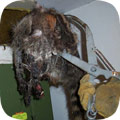 |
|
| This house was the worst-smelling house that I've ever been in. The odor was unbelievably wretched, both in stench and power. The house was completely unlivable. I knew, as did the owner, that a dead animal lay somewhere in the house, rotting. The smell had afflicted the house for ten days. I put on my HEPA filter mask and searched all around. I searched the attic extensively, but I couldn't find the source of the odor. Amazingly, I did find some living baby raccoons. I suspected that the mother raccoon must have died somewhere, but I could not find it. I ev...click for more |
05.01.2003 - Rat or Mouse in Ceiling - Trapping & Removal
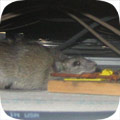 |
|
| This job took place in an office. Rats had been jumping on desks at night, knocking things over, chewing on documents, pooping in fax machines, and things
of that nature. I was called out to address the problem. The job started with a full inspection of the office building. Sure enough, it has several openings
that rats could use to gain access inside. The roof vents did not have proper screens, and there were several gaps where pipes came out of the concrete wall but were not
properly sealed around the edges. I saw the brown staining from the grease that ...click for more |
04.29.2003 - Bats in a Barrel Tile Roof
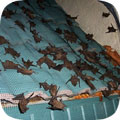 |
|
| Here we see part of the process of the exclusion of a colony of bats living in a barrel tile roof. This is part of a shopping plaza in SW Florida (a town called North Port). I was called because thousands of
bats had been going in and out of the roof, causing many problems. First of all, the bats were driving away customers - not only at dusk, when active, but also during the day, due to the noise and especially, the odor.
Bats have a very strong odor - both from their droppings and urine, and from their own bodies. A large colony can give off quite a strong odor. In this case, ...click for more |
04.27.2003 - Cute Baby Opossum in House
 |
|
| I went out at midnight to remove this little opossum from the bathroom of a home. I've already removed several small opossums from this house. The problem is that a female opossum has moved into the attic, and she has young with her. The little
ones run all around as they explore their environment. Some of them find holes leading down walls, and down they climb! This house has several openings that lead into the house - basically, architectural gaps. Most homes have a few. The baby opossoms have been
finding these areas and thus getting into the house. The ...click for more |
04.25.2003 - Raccoon Capture - Catching Raccoons
 |
|
| Baby raccoons are cute. Attics are hot. That's what I figured out during this job. A husband and wife called me with suspicion of raccoons in
the attic. When I asked why they suspected they had raccoons living in the attic, they said, "Well, we've heard some scratching and clawing up there at nighttime, and we
hear a sort of chattering that seems like it's raccoon sound, there's a scent that we think is raccoon poop, and every night we watch a fat raccoon climb the downspout and into
a vent hole leading into the attic". The evidence sounded good enough to me, so I head ...click for more |
04.22.2003 - Mole Capture & Removal
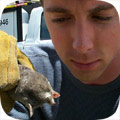 |
|
| Moles are a common nuisance animal throughout the country. The primary objection that homeowners have to this little creature is that they make a mess of lawns. They live underground, where they are extremely active, tunneling through soil and eating
about half their body weight each day in earthworms and grubs and such. They dig deep tunnels, which aren't noticed, but they also dig surface tunnels for both feeding and movement, and these tunnels create ridges all over a lawn. In addition, moles often dig deep chambers
in which to live or nest, and they often push ...click for more |
04.07.2003 - Raccoon Extermination
 |
|
| This is the largest raccoon that I've caught so far. The customer told me that he had a very large raccoon that was continually ripping into his
screened-in pool area, and that he needed a raccoon exterminator right away. I told him that I could help him, but that I don't really exterminate raccoons. I told
him that I trap them in live cage traps and relocate them far outside the city limits, so that it will never be able to come back again. "That's okay with me, just get
rid of it!" he said, "But I think you're going to need an awful big cage, this sucker is huge!". I have a special very ...click for more |
|
|
|
|
|


